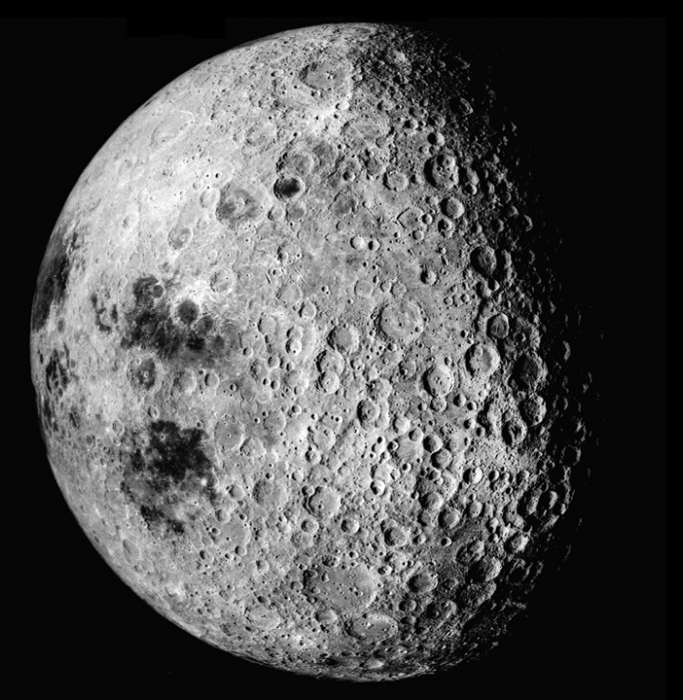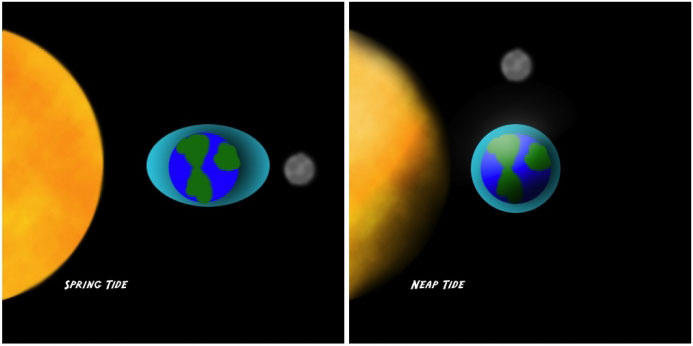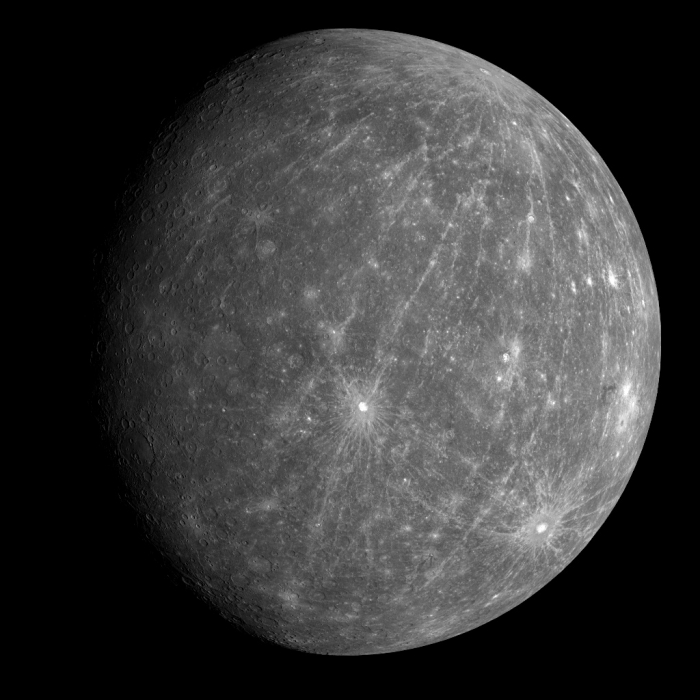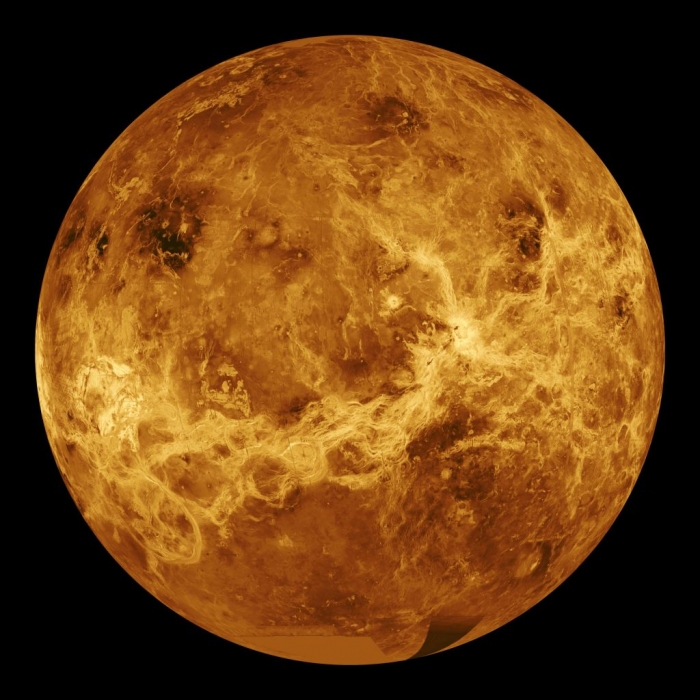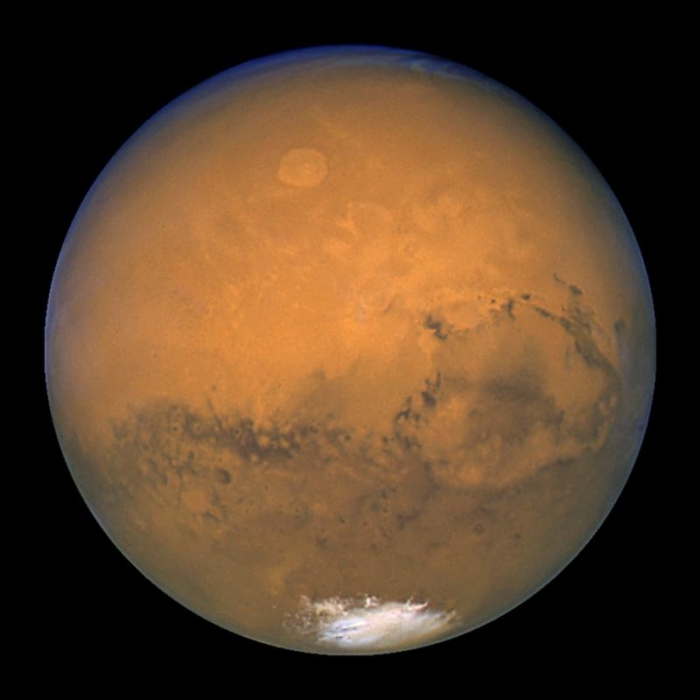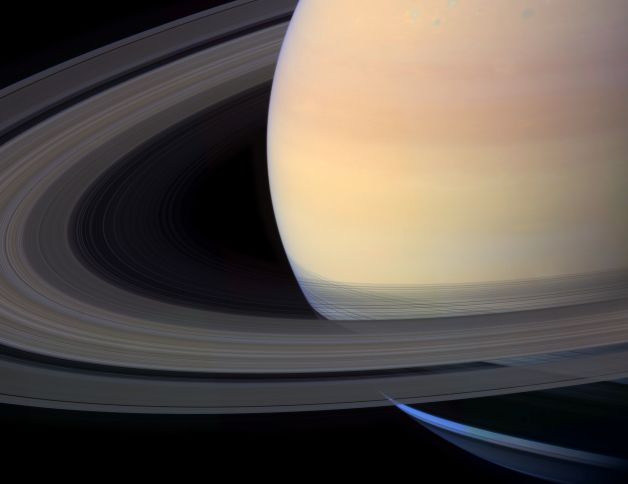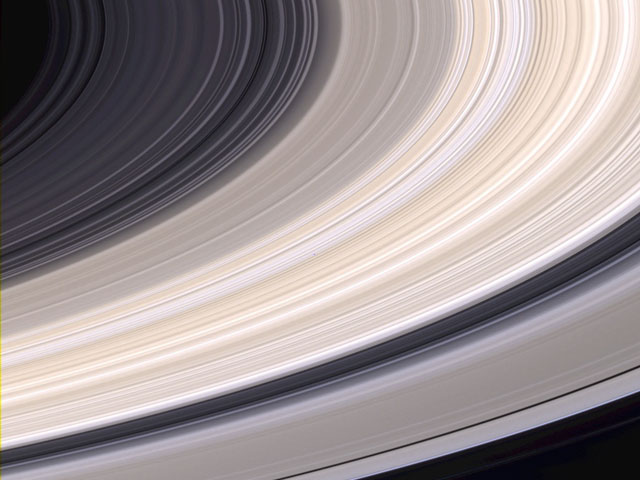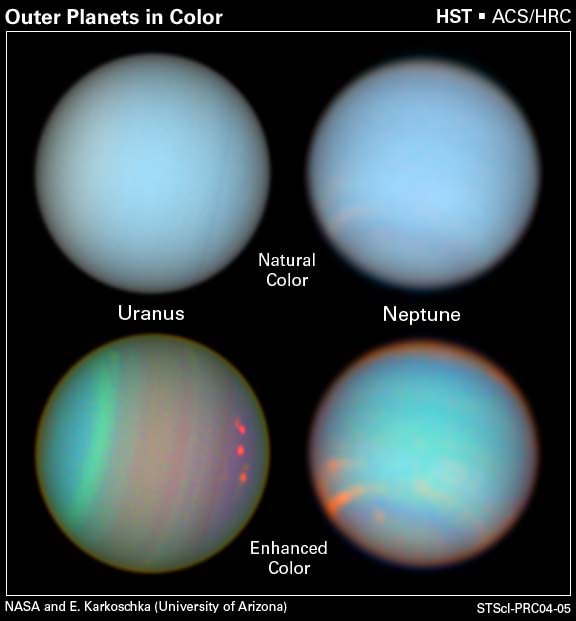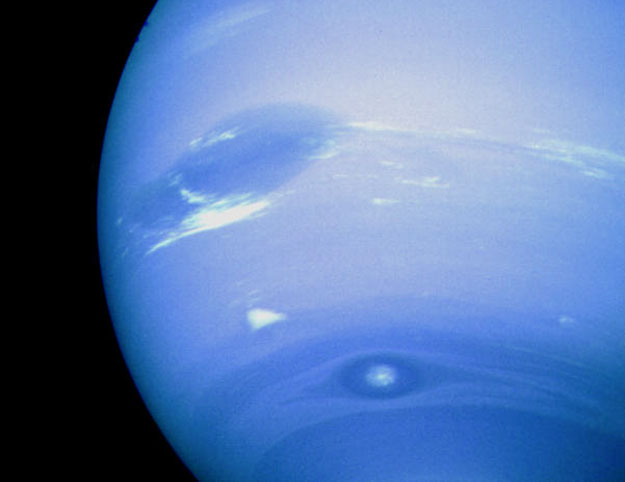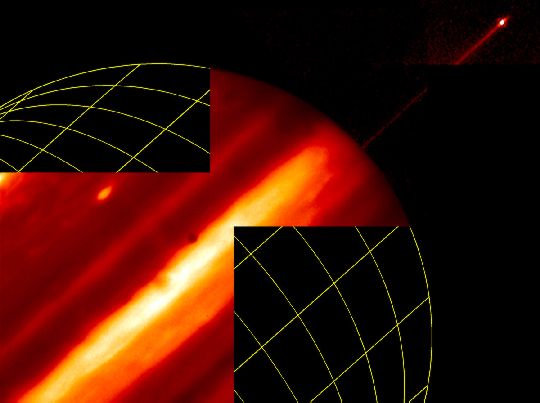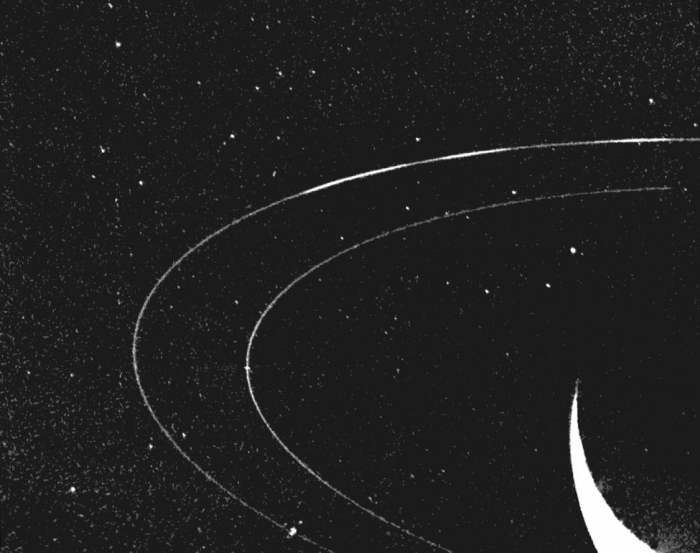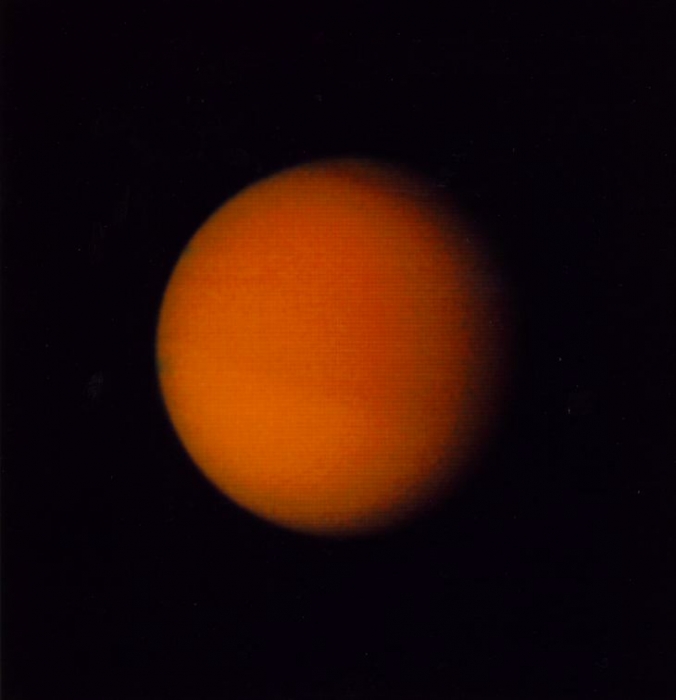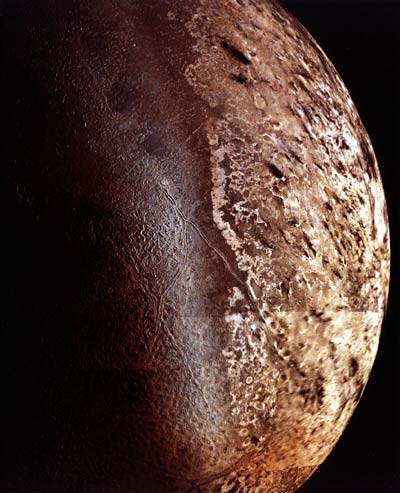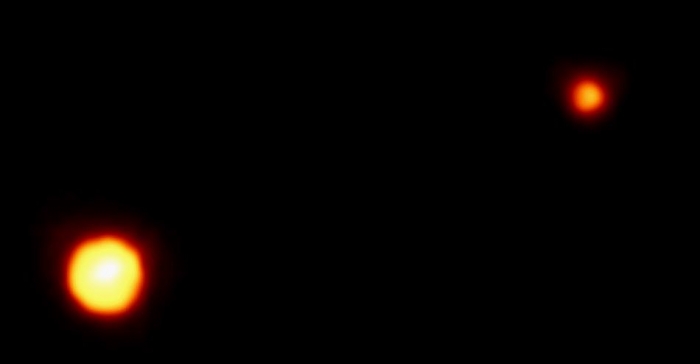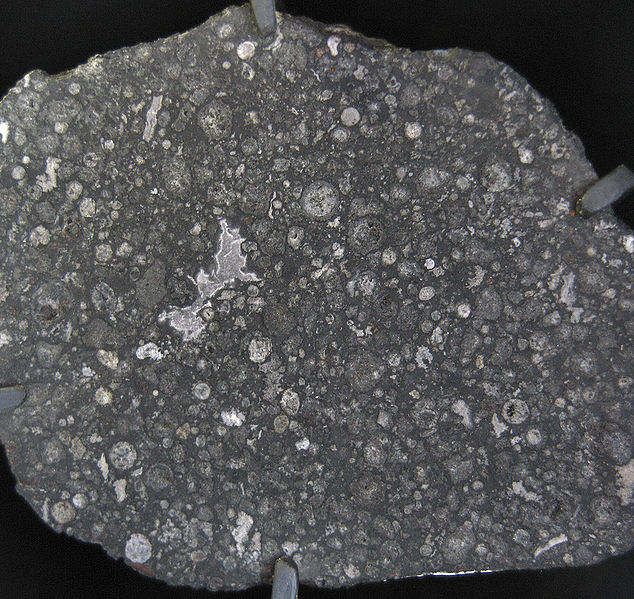Lesson 11
Overview
About Lesson 11

By the end of Lesson 11, you should be able to:
- Compare and contrast the interior structure and atmospheres of Mercury, Venus, Earth, and Mars;
- Qualitatively describe the process of tidal locking and relate this phenomenon to Mercury’s orbit around the Sun and the Moon’s orbit around the Earth;
- Describe the role impacts and collisions had on the evolution of the Inner Solar System planets and the Moon;
- Compare and contrast the terrestrial planets and the Jovian planets;
- Describe the processes for the formation and evolution of ring systems around giant planets;
- Compare and contrast the moons of the Jovian planets;
- Relate the appearance of the Jovian planets to atmospheric processes;
- Describe the relationship between Pluto and the Kuiper Belt;
- Explain the origin of comets and their distribution in the Solar System;
- Describe the process by which a “shooting star” appears in the night sky.
What is due for Lesson 11?
Lesson 11 will take us two weeks to complete.
Please refer to the Calendar in Canvas for specific time frames and due dates.
There are a number of required activities in this lesson. The chart below provides an overview of those activities that must be submitted for Lesson 11. For assignment details, refer to the lesson page noted.
| Requirement | Submitting your work |
|---|---|
| Lesson 11 Quiz | Your score on this quiz will count towards your overall quiz average. |
| Unit 4 Lab | During Lesson 11, you will work on, and complete, the Extrasolar Planets lab (Lab 4). |
Questions?
If you have any questions, please post them to the General Questions and Discussion forum (not email). I will check that discussion forum daily to respond. While you are there, feel free to post your own responses if you, too, are able to help out a classmate.
The Earth / Moon System
Additional reading from www.astronomynotes.com
We are going to begin this lesson with a study of some of the properties of the Earth. We are going to focus on some of the physical processes that occur on Earth, and then we are going to discuss how the other inner planets differ from our observations of the Earth. We will emphasize the interior, the crust, and the atmosphere.
Atmosphere
The Earth has an atmosphere that consists of a mix of various gases (roughly 80% nitrogen and 20% oxygen, with small traces of argon, carbon dioxide, water vapor, and others) that is retained by the Earth's gravity. The Moon has no atmosphere today because its gravitational field is weaker than Earth's, and it wasn't strong enough to retain whatever primordial gases were there originally. The atmosphere helps to regulate the temperature on the Earth, keeping it within a fairly narrow range from day to night. On the Moon, the temperature can vary by 300 degrees during one Moon day — it is hotter than boiling water when the Sun is directly overhead on the Moon and is much colder than water's freezing point on the night side of the Moon.
The temperature on Earth is influenced by the Greenhouse Effect (this name comes from an analogy that isn't perfect, but is close enough for our purposes). This works as follows:
- The Earth absorbs visible light from the Sun.
- The Earth's surface heats up and radiates light in the infrared part of the spectrum.
- Water vapor and carbon dioxide (primarily) in the atmosphere absorb the infrared light from the surface, heating up the atmosphere.
- The atmosphere radiates infrared radiation at the surface of the Earth, also heating it up.
When this process is in equilibrium, the temperature of the Earth varies around a mean temperature from year to year. The discussion about global warming arises from the observation that the increase in carbon dioxide in the atmosphere (mostly due to humans burning fossil fuels) correlates with the steady increase in the mean temperature of the Earth because of an increase in the magnitude of the greenhouse effect.
Apart from the fact that we breathe the gas in the Earth's atmosphere and that the atmosphere keeps the temperature of the Earth warm enough for us to exist, the atmosphere also has played a role in shaping the Earth's surface. We do not see very many craters on the Earth, although there are a few, including "Meteor Crater," or "Barringer Crater," in Arizona.
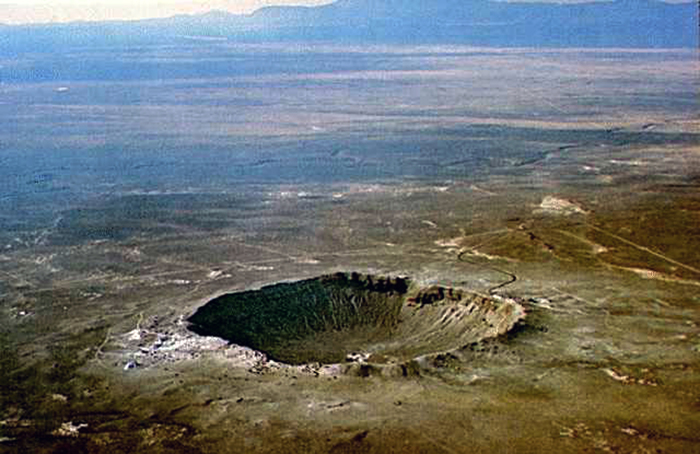
On the Earth, the atmosphere protects us from the impacts of some objects, but the weather also erodes craters over time, making them no longer visible. Satellite images reveal the existence of some ancient craters on Earth, including Manicouagan Crater.
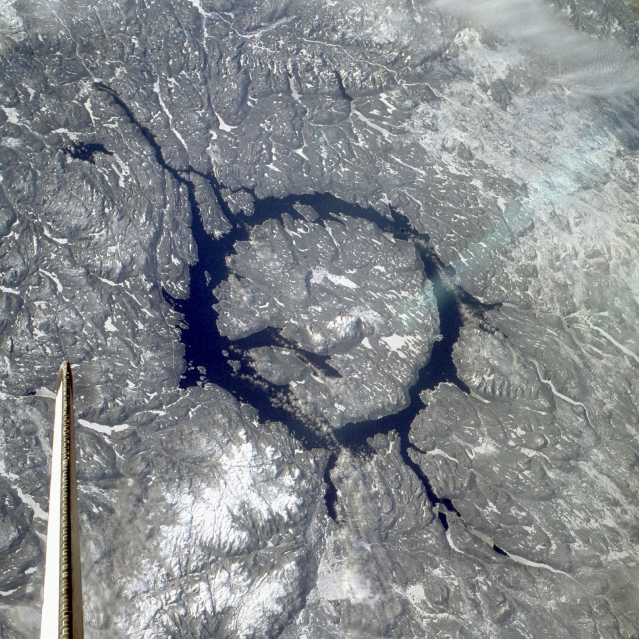
Try this!
Using the free application "Google Earth," you can tour the Meteor Crater and Manicouagan Crater from Google Earth to get a sense of their real scale. Can you find any other craters on Earth using Google Earth? If you want to skip right to the answer, you can see the database of currently identified craters in the "Earth Impact Database".
You can compare the Google Earth images of the surface of the Earth to the Google Moon images of the surface of the Moon (Note: In the Google Earth application, you can now also bring up the 3D map of the Moon; instructions are available on the Google Moon website). How does the appearance of the Moon's surface differ from Earth's?
The Moon is very different. Since it lacks an atmosphere, most of the impact craters that formed on its surface are still visible today, and they will never erode away like those on Earth.
Crust and Interior
When we discuss the surface and the structure of the planets, we are going to focus on their density, because this property tells us a lot about the composition of the planet. Recall, the density is the mass of an object divided by its volume. If you consider comparing a cube of sugar to a cube of lead that is the same size, you will expect the cube of lead to feel heavier than the cube of sugar. This is because in the same volume (a cube of the same size), the lead will contain more mass than the sugar. The metric system was designed so that one cubic centimeter of water has a mass of 1 gram, so we say that the density of water is 1 gram per cubic centimeter (or equivalently, 1000 kilograms per cubic meter, which is another popular unit of measurement for density). The rocks and metals that we are familiar with are all denser than water. A typical rock has a density of about 3 g / cm3 and a typical metal (say iron) has a density of about 8 g / cm3.
Our measurements of the Earth's mass (from Kepler's Laws) and its volume (from its measured size) tell us that its average density is about 5.5g / cm3 — about half way between rock and iron. By studying data from earthquakes around the world, geologists have determined that the Earth is not uniformly made up of the same material. Instead it is differentiated into different layers. We live on the crust. Below the crust is the mantle, and below the mantle is a core. The crust is about 3 g / cm3 and the inner core is about 12 g / cm3, which suggest the crust is made up mostly of ordinary rock, and the inner core is denser than the metal lead. The mantle is a rocky layer intermediate in density between the crust and the core, and it is semi-fluid, somewhat like the consistency of bubble gum or flexible plastic. The crust of the Earth sits on top of the mantle, and because of convection (a process which occurs in fluids with a temperature difference between different layers — the warmer fluid rises, cools off, and then sinks, creating a flow) in the mantle, the plates that make up the crust are very slowly moving with respect to each other. This process of plate tectonics is the cause of earthquakes, the source of mountains and trenches under the oceans, and is one you will discuss in much more detail in the other courses in this program (e.g., EARTH 501 and EARTH 520). For the purposes of ASTRO 801, you should keep in mind though, that on Earth, plate tectonics is ongoing. We will want to consider if this is true of the other objects in the Solar System as we compare and contrast the planets and moons.
The Moon is very different. The average density is 3.3 g / cm3, but more importantly, there is less variation in the density from core to crust than the Earth. The Moon is not geologically active — there are no volcanoes or plate tectonics on the Moon. Equipment left behind by the astronauts who landed on the Moon has detected Moonquakes, but they are very mild. Interestingly, it looks like the core in the Moon is off center. The crust is about 60 km thick on the near side (facing Earth), but it is 150 km thick on the far side. In 2014, my Penn State colleagues published a new study suggesting that this variation in the thickness of the Moon's crust was caused by the very hot, molten Earth heating the Earth-facing side while the far side of the Moon cooled off.
The surface of the Moon shows two very different regions. The dark regions (the Maria) are lowlands that were filled in by molten mantle material (lava) about 3.5 billion years ago. The light colored areas are highlands that are made of the original crust of the Moon. You can tell that the Maria are younger than the light colored regions because they have fewer craters. Originally, there were just as many craters in the Maria region as there are everywhere else, but when the molten rock filled in these regions and solidified, it covered many of them. Because the Moon has no atmosphere, the craters are very well preserved, giving us details on what the number of impacts was like in the early history of the Solar System. In the image below, you can see the Maria have few craters, while the other regions of the Moon are speckled with dark craters.
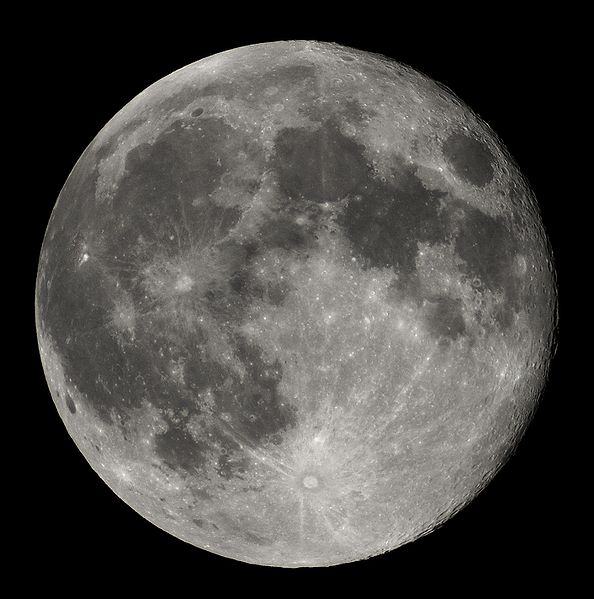
The far side of the Moon (the half that is never pointed towards Earth) looks very different from the side that we see; there are no Maria. This is attributed to the difference in the crust thickness. Since the far side of the Moon is about twice as thick, Lava was not able to penetrate the crust to fill in the lowlands, solidify, and create Maria.
The current leading theory for the formation of the Moon suggests that it was created in a collision between the proto-Earth and a Mars-sized object. Computer simulations of a collision like this show that the material that breaks off of the proto-Earth should wind up coalescing into a Moon-sized object in orbit around the Earth. The material that created the Moon would have come from the crust and mantle of the proto-Earth, which explains its lower density than the Earth. There is an excellent visualization of this in the video "Cosmic Collisions", which was released by NASA and the American Museum of Natural History. AMNH appears to have removed all of the public links to the video, but the History Channel has a good, similar video that includes most of the details in the Cosmic Collisions video.
Tides
Additional reading from www.astronomynotes.com
The Earth and the Moon directly influence each other, so it is best to think of these two objects as part of one larger system, rather than two separate, individual objects. Compared to the Earth, the Moon is relatively large. It has 1% of Earth's mass, and has 1/4 the Earth's radius. The Earth and Moon can almost be considered a binary planet system. The most notable influence that the two objects have on each other is tides.
The figure below shows the force of gravity felt by the Earth from the Moon. It is strongest just below the Moon and weakest on the side of the Earth opposite from the Moon (as indicated by the arrows). After you subtract off the mean force, you are left with the schematic diagram of the Moon's differential gravity field on the Earth in the bottom of the image. This shows how the Moon tidally deforms the Earth, creating two areas of high tide per day. This effect is most noticeable as the oceans and other bodies of water respond to the Moon's gravitational tidal force. Below the Moon, ocean water, for example, gets pulled into a high tide. One way to think of the reason for the high tide on the opposite side of the Earth from the Moon, is that the water gets "left behind", because it isn't being pulled as strongly as the center of the Earth, so there is a high tide on that side, as well. On the two sides of Earth perpendicular to the Moon, the net effect is that the water gets squeezed towards the center of the Earth, causing low tides at these two locations. As the Earth rotates once around during a 24 hour day, each location goes through high tide, low tide, high tide, and low tide.
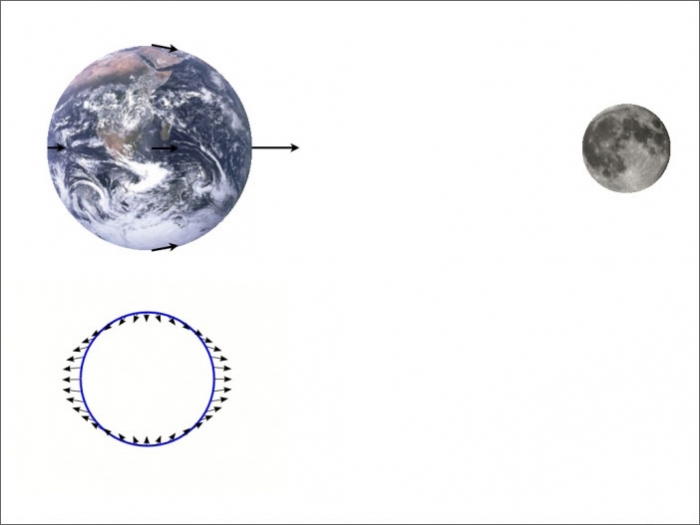
For an animation of this effect as the Moon orbits the Earth, see NOAA's animation of the tides, which is part of a detailed tutorial on the tides.
In the animation on the NOAA site, you can see how the Sun also contributes to the tides on Earth. The tidal force on the Earth from the Sun is weaker than the tidal force on the Earth from the Moon. The way we observe the effect of the Sun is that when the Moon is in its Full or New phase, the Sun enhances the tidal effect of the Moon, leading to higher high tides. These are called spring tides. When the Moon is at 1st or 3rd Quarter (i.e., the Sun/Earth line is perpendicular to the Moon/Earth line), the Sun's tidal force cancels some of the Moon's tidal force, leading to lower than normal high tides. These are called neap tides. The images below illustrate the difference between the two.
Check it out!
You should note that even though many images in textbooks and from reputable sources like NOAA show the tidal bulge of the Earth pointing directly at the Moon, the true behavior is that the bulge is not aligned perfectly with the Moon—there is a delay.
Tides in the Earth/Moon system have led to an effect called tidal locking, and the Moon is now in a synchronous orbit (its rotation period is equal to its orbital period around the Earth). This effect is common, and occurs in many other systems. In the case of the Earth/Moon, this is how it works:
- The tidal bulge on the Earth rotates as the Earth rotates, and in general, the high tide bulge doesn't point straight at the Moon like in the image above. Instead, as illustrated in the ClassAction animation, the Moon lags behind the bulge.
- The force of gravity from the Moon pulls the deformed Earth in the direction opposite to its rotation, causing the Earth's rotation period to slow down. You might remember this by thinking that the tidal bulge is shifting in order to line up with the object causing it.
- The Moon gets deformed by the Earth, too, although since there is no water on the Moon, the effect isn't as obvious. However, the tidal bulge on the Moon has already shifted so that it points directly at the Earth. This is why the Moon always points the same face to the Earth.
- Because of Newton's third law (equal/opposite reaction), as the Earth slows down because of the Moon's pull, the Earth is pushing the Moon slowly away from the Earth. It gets farther away from us year after year.
Summary
To summarize the Earth/Moon system, we find that the two are rocky objects with different densities. Both are differentiated, with different layers of different density material in the crust, mantle, and core. The Earth's crust changes over time (plate tectonics) and the Earth's atmosphere continues to evolve, too. The Moon's crust is mostly unchanged since the event that created the Maria, and its lack of atmosphere means that the surface is unlikely ever to change. The Earth and Moon directly influence each other through tides, and the Moon has actually achieved a tidal lock to the Earth, which causes it to keep one face permanently pointed at the Earth. We will find that the other planets in the inner Solar System share some of the properties of the Earth / Moon system, but each also has some of its own peculiarities.
We should expect that the phenomena and the processes that influenced the Earth and the Moon during their evolution should have also influenced the other planets, as well. For example, tidal locking is observed in other parts of the Solar System (and other solar systems and star systems), too.
The Inner or Terrestrial Planets
Additional reading from www.astronomynotes.com
Start Here!
Please review the properties of the Inner Planets at Bill Arnett's Nine 8 Planets website, an excellent resource.
Additionally, there is a great deal of information (with no annoying ads, like in the previous link) at NASA's Solar System Exploration page.
Our goal for this lesson is to come up with a list of the similarities between the planets, some trends in their properties, and an understanding of where some of the discrepancies in their properties may lie. To achieve this, we can begin with a simple bullet list that includes a summary of the properties of each of the three Terrestrial planets:
Mercury
- Surface heavily cratered—in some ways very similar to Earth's Moon.
- Very dark—only reflects a small amount of Sunlight (it has a low albedo).
- Temperature on the surface varies from 100K to almost 700K.
- In a 3:2 synchronous orbit with the Sun—three Mercury days (59 Earth days each) = two Mercury years (88 Earth days each).
- The iron core of Mercury is very large, taking up most of the interior of the planet and creating a relatively strong magnetic field for a planet of its size.
- No moon.
- Less than the size of the Earth.
- Visited by satellite Mariner 10—most of our knowledge comes from this one mission. The NASA Messenger mission studied Mercury in recent years; it entered orbit around Mercury in March 2011 and studied it continuously before crashing to the planet's surface in 2015.
- Messenger somewhat surprisingly revealed that Mercury has water ice in shadow in craters at its poles!
Venus
- Thick atmosphere and "runaway greenhouse effect" causes 730K surface temperatures.
- Atmosphere consists mostly of CO2 (carbon dioxide), clouds of sulfuric acid—no water vapor or oxygen.
- Huge volcanoes.
- Clouds are highly reflective (high albedo)—Venus is one of the brightest objects in our night sky.
- Rotates very slowly (243 Earth days) and it rotates in a retrograde manner (opposite of the Earth & Sun).
- Not in a synchronous orbit—one Venus year = 225 Earth days.
- No moon.
- Almost identical in size to the Earth.
- A number of missions to Venus have been sent by the USA and USSR. In 1994, Magellan mapped the surface of Venus.
Mars
- Temperature always below the freezing point of water.
- Giant volcanoes (largest of any in the entire Solar System).
- Intense, large-scale dust storms.
- Has an atmosphere that is much thinner than Earth or Venus, mostly CO2.
- The surface is red because of the presence of iron oxide (rust).
- One Mars day is only slightly longer than an Earth day (24.6 hours).
- One Mars year is 1.88 Earth years.
- Polar caps of dry ice and water ice that change with the seasons.
- Frozen water in a permafrost layer (recently confirmed).
- About half the size of Earth.
- Two small, irregularly shaped moons—Phobos and Deimos.
- The most visited planet in our Solar System, including several recent missions, Mars Exploration Rovers Spirit and Opportunity, the Phoenix Lander, Curiosity, and MAVEN.
Interior structure
There are several peculiarities about these planets, but we can understand the likely causes of these properties when we contrast them to the Earth. First, consider the interior structure of these planets. Just like the Earth, Mercury, Venus, and Mars are differentiated. Curiously, we find that, compared to the other planets, Mercury's core is relatively large. That is, it fills up most of the interior of this planet. Because the core of Mercury is probably mostly made up of iron and nickel and it fills so much of the planet's interior, Mercury is the densest inner planet. We expect that some of the core of each of the inner planets is molten, and we expect that this liquid metallic core must generate electric currents inside the planet as the core rotates with the rest of the planet. These electric currents should create magnetic fields, making the planets behave as if they have giant bar magnets inside them. Both Mercury and the Earth have measurable magnetic fields, but, contrary to our expectations, Venus and Mars do not. For Venus, the reason may be that it rotates too slowly to create the necessary conditions to create a magnetic field. The lack of magnetic field on Mars may be caused by its lack of a molten core.
Albedo
We observe the inner planets easily because they are nearby and shine by reflecting sunlight. You can see Mercury, Venus, and Mars at different times of the year without any instruments like a telescope or binoculars—all three of these planets are visible to your naked eye. Although all of the planets reflect sunlight, different materials reflect different amounts of sunlight. For example, look at the Earth at the NASA: The Blue Marble site. We see that the brightest parts of the Earth are the clouds and the ice near the North Pole. The darkest parts of the globe are the patches of deep ocean that are not covered by clouds. The amount of light reflected by a surface is called the albedo. For light colored clouds, the albedo is high, and much of the incoming sunlight gets reflected. Water and dark colored rock reflect much less light. Mercury is mostly covered by dark rock, so its albedo is very low. On the other hand, Venus is covered by a thick layer of clouds, so it reflects almost all of the Sunlight that hits it. Because of Venus' high albedo and its proximity to the Earth, it is the brightest object in the night sky after the Sun and the Moon.
Atmosphere
Observations of these planets tell us that all three have atmospheres. Mercury has a very thin atmosphere with a strange composition. Mercury is so small that gas easily escapes from its gravitational pull, so its atmosphere must be regenerated continually, perhaps by the bombardment of the surface of the planet by energetic particles from the Sun. Venus, on the other hand, has a thick, dense atmosphere. The greenhouse effect has "run away" on Venus, making the surface temperature hotter than Mercury, even though it is farther from the Sun. Mars' atmosphere is much thinner than Venus or Earth, and it consists primarily of carbon dioxide. The atmosphere of every inner planet originated when the planet was formed and has been supplemented by gas that has escaped from underneath the crust.
The laws of physics tell us that the hotter a gas is, the faster the particles inside that gas move. For Mercury and Mars, these planets are so small that they have weak gravitational fields, which means that much of the gas in their atmosphere can escape if it is warm enough (the average speed of the particles in the gas exceeds the escape velocity from the planet). For Venus and the Earth, which are more massive and have stronger gravitational fields, the lightest gases can escape, but gases like carbon dioxide and nitrogen do not.
Additionally, on the Earth, we know that plant and animal life process the gas in the atmosphere. For example, humans breathe oxygen and exhale carbon dioxide, while plants use carbon dioxide and produce oxygen. Because of these biological processes on the Earth, our atmosphere has evolved significantly from its original content. The Earth's atmosphere may have once been much like Venus' atmosphere is now, however, as plant life on the Earth arose, the process of photosynthesis contributed to the removal of carbon dioxide and the increase in oxygen content.
Rates of rotation
There is also some diversity in the rotation rates of the inner planets. We are most familiar with the Earth. It rotates in a counterclockwise direction in close to 24 hours. Mars is quite similar to the Earth. Its rotation axis is tilted by 24 degrees (Earth's axial tilt is 23.5 degrees), and its rotation period is just over 24 hours. So on Mars, the length of the day and the variations in the height of the Sun above the horizon over the course of one Mars year are similar to what we are used to on the Earth. Mercury has become tidally locked to the Sun, similar to how the Moon is locked to the Earth. However, in the case of Mercury, the planet rotates in 59 days and orbits the Sun in 88 days. What this means is that Mercury rotates completely on its axis (that is, 360 degrees) 3 times in the same amount of time it takes to orbit the Sun 2 times. This is referred to as a 3:2 resonance. In the case of the Moon, since it orbits the Earth 1 time in the same amount of time as it rotates 1 time, this is referred to as a 1:1 resonance. Although this seems a bit peculiar, Venus' rotation properties are much stranger. It takes 243 days to rotate once (and there is no tidal locking, so the Venus year has nothing to do with the Venus day), but it rotates in the opposite sense compared to Mercury, Earth, and Mars. All of these planets orbit the Sun in a counterclockwise direction, and Mercury, Earth, and Mars rotate counterclockwise around their axes. Venus rotates slowly in a clockwise manner around its axis. One theory is that a collision or collisions with Venus by other objects caused its rotation sense to reverse, but an alternative theory is that the tidal influence of the Sun and the other planets in the Solar System may also have caused this unique rotation.
Want to learn more?
Recall that Starry Night allows you to travel to the surface of each planet. If you would like to compare the rotation rates, orientation of the axis of rotation, and orbital periods for each planet, you can travel to Mercury's, Venus', or Mars' surface, set the time flow rate to 3000x (or the time step rate to say 1 Earth day), and as time goes by note the location, date, and time of sunrise and sunset, the height of the Sun above the horizon, and the length of 1 day on that planet.
You can also choose to hover over a point on the surface, and if you choose to hover over the north pole of each planet, you can watch them rotate below you. For Venus, you will have to turn up the time flow rate to a very high number in order to see it rotate at all.
Jupiter
A course on astronomy requires you to try to understand much larger numbers and much larger units of measurement than we are used to in our day to day experience. For example, we have already studied the distances to stars, the sizes of galaxies, and the age of the observable universe, all of which are very large (tens of trillions of kilometers, millions of trillions of kilometers, billions of years). Now that we are studying the Solar System, the planets are tiny relative to stars, galaxies, and the universe.
With this in mind, though, if we compare the planets to each other, Jupiter is the largest, and it is an immense planet. In our everyday experience, Earth seems large, since it has a diameter of more than 12,000 kilometers. Jupiter is about 12 times larger in radius, which means that it is about 1400 times larger in volume than the Earth (that is, about 1400 Earths could fit inside Jupiter).
If Jupiter was made of similar materials as Earth (iron core, rocky crust), then its mass would be about 1400 times larger than Earth, too. However, we find that Jupiter's mass is only 300 times larger than Earth, which tells us that its density (its mass divided by its volume) must be smaller than Earth's. Here is how you can convince yourself this is true:
If you recall our discussion of density previously, water has a density of exactly . Does this mean that Jupiter is made of water, and if so, what form is it in (water vapor, ice, liquid water)?
In fact, Jupiter is not made of water. Its composition is very similar to the Sun's. It is made up primarily of Hydrogen and Helium, with traces of other elements and molecules. Observations of Jupiter show us that what we see as its “surface” is in fact its atmosphere—the observable portion of this planet is entirely gaseous. Look at the following image from the Cassini satellite.
If you look at some of the fine details in the image, you will not see anything that looks like the continents on Earth, the craters on Mercury, or the rocky plains of Mars. Instead, it looks more like the clouds of Venus, which obscure that planet's surface. Animations, such as the Cassini movie of the Great Red Spot produced from images taken by the Cassini satellite, show that the visible atmosphere is in constant motion, and even appears to have nearly circular storms that do not look all that different from hurricanes on Earth.
The atmosphere of Jupiter shows a lot of structure. It has alternating dark and light colored bands, which are not smooth, but which contain swirls and eddies. One of the reasons for the banded structure in Jupiter's appearance is that convection is occurring in the atmosphere. Convection occurs when you have a temperature difference between the layers in a liquid or gas. The common example is putting cream in a cup of coffee—since the cream is colder than the coffee, it sinks to the bottom, where it heats up. Then, when it heats up, it rises to the top, where it cools off, and then sinks again. So the process of convection creates a circular current in the fluid. This is going on in Jupiter's atmosphere, and what we observe as the different colored bands are actually different layers in the atmosphere. The light-colored areas (called zones) are the bands that are rising, while the dark-colored areas (called belts) are the layers that are sinking. As the “air” (the mix of gases that makes up Jupiter's atmosphere, which is different than air on Earth) rises, clouds form out of different materials—water, ammonium hydrosulfide, and ammonia. The whitish zones are the high layers of ammonia clouds, while the darker belts are the lower layers of ammonium hydrosulfide clouds. The exact cause of the colors remains an open question for researchers. Inside the clouds, reactions between sunlight, lightning, and different chemical compounds probably give rise to the variety of colors seen in Jupiter's atmosphere, but exactly what processes give rise to which colors has not been determined yet.
Jupiter has been visited by several missions, the most recent being Juno. Juno passed very close to Jupiter, and, in particular, studied its polar regions. This mission revealed previously unknown details about Jupiter, like every NASA Solar System exploration does when it visits a world.
Just like in the atmosphere of Earth, storms develop in the atmosphere of Jupiter. Unlike the Earth's atmosphere, however, some of the very large storms achieve a level of stability that allows them to persist for hundreds of years, and perhaps even longer. The most famous storm in Jupiter's atmosphere is called the “Great Red Spot,” which is a rotating storm larger than the Earth! Here are some photos of this famous storm:
- APOD: The Great Red Spot
- APOD: The Great Red Spot and the Smaller White Oval
- Hubblesite: Changes in the Great Red Spot
Smaller storms in Jupiter's atmosphere appear, disappear, merge, and change in relatively short time scales. However, the Great Red Spot has persisted for at least 300 years. It can be seen to change over time. The Great Red Spot has some similarities to hurricanes on Earth, with the main difference being hurricanes are clockwise rotating, low pressure storms, while the Great Red Spot is a counterclockwise rotating, high pressure storm. On Earth, when these storms hit land, they can lose energy quickly, and the storm will dissipate. Since the Great Red Spot has not dissipated, this tells us that (1) there is some source of energy continually supplying it with enough to remain stable, and/or (2) there is no solid land underneath it to cause it to lose energy rapidly.
Although astronomers have no direct way of observing Jupiter's interior, we have some evidence that suggests what it may be like. Although this planet is made up primarily of hydrogen and helium, which are found in gas form on Earth in normal conditions, the conditions in Jupiter's interior are unlike those on Earth. Given the temperature and pressure on Jupiter, we think that most of the planet is actually liquid hydrogen. What lies beneath this liquid layer is even more of a mystery. We expect that there may be a small solid core (about the size of the Earth) at the very center of Jupiter that is made up of rock, metals, and solid compounds of hydrogen.
If you recall our discussions of the night sky, we discussed how many of the planets are easily visible to the naked eye. The inner planets do not emit any of their own light. Instead, they are visible because they reflect sunlight. This is not strictly true for Jupiter. If you measure how much total light it emits, it is more than the amount of sunlight that reaches the planet. Like the persistence of the Great Red Spot, which suggests some internal mechanism is providing energy to the cloud layers, the fact that Jupiter is giving off more light than it receives also suggests there is some internal energy generation. When we discussed protostars, we saw how they generated energy through gravitational contraction before nuclear fusion began. In the case of Jupiter, it does not contain enough mass to ever achieve the internal temperature and pressure to begin nuclear fusion, but it can generate energy through gravitational contraction.
The Outer or Jovian Planets
Additional reading from www.astronomynotes.com
Through even a small telescope, both Jupiter and Saturn look beautiful. Many people, myself included, feel that Saturn is by far the most beautiful of all of the planets. Much of Saturn's aesthetic appeal comes from its magnificent ring system.
The rings of Saturn orbit the planet around its equator, and, although they are very thin, they extend out almost 300,000 kilometers from the planet. The pair of images from Hubblesite shown below will help you understand exactly how thin they are—when we see them nearly edge-on, they almost disappear!
Even though they are 300,000 kilometers in radius, Saturn's rings are only about 20 meters thick. An analogy is to picture a compact disc (CD) that is the same thickness as usual, but 30 kilometers (about the size of an average town) in diameter!
The rings of Saturn were probably created by the destruction of an object that got too close to the planet. We know that Saturn's rings are made up of many small particles. Even though they look like they may be solid in all of the images that you have seen, they are not! If you look back at our discussion of tides in the last lesson, we studied how the gravitational force of the Moon deforms the Earth and vice versa. If you think about it, if a tidal force is strong enough, it might be able not only to deform an object, but also to actually break the object into pieces. There is a limit, called the Roche limit, which is a roughly spherical region that surrounds each planet (and star). Outside the Roche limit, an object will be deformed by the planet's tidal force, but will otherwise be OK. If an object gets inside the Roche limit, though, the tidal force from the planet will be stronger than the force of gravity holding the object together, so it will be destroyed. The rings of Saturn are inside of the Roche Limit for this planet, so it seems likely that they were formed by the disruption of some massive object.
From the ground, there only appear to be a few rings with a relatively wide, dark gap called the Cassini Division between the rings. However, views from spacecraft like Voyager and Cassini show that the rings are actually made up of many thin ringlets. It appears that there may be up to several hundred thousand ringlets.
Other than its ring system, however, Saturn is in many ways similar to Jupiter. It is the second most massive and second largest planet in the Solar System. Saturn rotates once on its axis very quickly, about 11 hours, which is very similar to Jupiter, which rotates in approximately 10 hours. If you look at an image of the whole disk of Saturn, you find that it appears to be not quite spherical, but it is flattened because of its fast rotation. Saturn is, again, primarily a gaseous planet with perhaps a small solid core, but its density is significantly different from Jupiter's—it is 0.7 g / cm3, which is less than water! An often repeated joke is that if you could build a bathtub big enough, Saturn would float, but it would leave a ring.
In most pictures, Saturn's atmosphere appears to have less structure than Jupiter's. This is very likely because the colder temperature of Saturn causes different chemical reactions to occur in the atmosphere. However, if you process the images to enhance the contrast, you will see that the atmosphere of Saturn does show many of the same structures that we see on Jupiter, as shown in these Hubblesite images:
Uranus and Neptune
Every planet that we have studied so far was known to ancient astronomers because they are all visible to the unaided eye. Uranus and Neptune, however, are only visible with a telescope. In many ways, these two planets seem similar, but when we study them in some detail, we will find that they have some significant differences. Both Uranus and Neptune are gaseous planets like Jupiter and Saturn, but they are much smaller. They are both about 4 times the diameter of the Earth, and they are about 15 times more massive than Earth. Although this is large, for perspective it is 20 times less massive than Jupiter.
Images of these two planets show that in natural color, Uranus and Neptune look to be a blue-green color. This is usually attributed to the presence of a mix of methane and molecular hydrogen in the atmospheres of these planets. The atmosphere of Uranus appears to be very plain. It does not show banding, storms, or any of the features seen on Jupiter or Saturn. However, the Voyager satellite did show dark spots on Neptune that appear to be storms similar to the Great Red Spot on Jupiter.
It seems very strange that Neptune should show such strong evidence of activity in its atmosphere when Uranus does not. In the case of Uranus, it is very cold—only about 58 kelvin. It also does not show any evidence of generating energy in its interior, so it is believed that the lack of internal energy generation keeps the atmosphere from creating the prominent structures seen in Jupiter and Saturn. Neptune is even more distant than Uranus, so we expect that it should be colder. The measurement that Neptune is 59 kelvin (that is, slightly warmer than Uranus) suggests that it does generate energy, emitting almost 3 times as much light as it receives from the Sun. So, it may be that it requires internal energy generation to create the strong weather patterns in the gas giants. Why, then, is Uranus the only Jovian planet which does not appear to generate energy in its interior?
Recent observations by Hubble shows that Uranus' atmosphere is beginning to show new structure. Uranus, it turns out, has a very strange rotation. Most of the planets rotate so that the poles of their rotation are pretty closely aligned with the poles of their orbit. Another way to visualize this is that the equator of most planets is aligned with the plane of the planet's orbit around the Sun. However, the pole of the rotation of Uranus is almost perpendicular to its orbit. That is, the pole of Uranus' rotation is tilted by almost 90 degrees compared to that of Earth. Because of this, Uranus keeps its pole pointed towards the Sun and not its equator. So for about 1/4 of its orbit, its South Pole never sees the Sun, and for 1/4 of its orbit, its North Pole doesn't see the Sun. It takes Uranus 84 years to orbit the Sun once, and just a few years ago its South Pole started getting sunlight again. This may be why its atmosphere is beginning to increase its activity compared to when Voyager visited decades ago. Thus, it may be that Uranus' odd rotation may be responsible for its apparent difference from the other Jovian planets in terms of its internal energy generation.
There is one other peculiar feature of Uranus, but this one it shares with Neptune. The gas giant planets have magnetic fields, just like Earth. In fact, Jupiter has an incredibly intense magnetic field. Uranus and Neptune both have magnetic fields, but in each case, the center of the field is offset from the center of the planet, and the pole of the magnetic field is significantly offset from the pole of the planet's rotation. In the case of the magnetic fields on Earth and Mercury, we think that these are created by a rotating liquid metallic core. The proposed model for the magnetic fields in Uranus and Neptune is that in their case they are created in an outer layer and not in the core, which can lead to their measured offsets from the core and the rotation axis of the planet.
Rings and Jovian Moons
Additional reading from www.astronomynotes.com
Ring systems
Saturn is the only gas giant planet that has a prominent, easily observable ring system. However, observations have revealed that each of the Jovian planets have ring systems. Jupiter's ring is exceptionally faint. The particles in Jupiter's ring are smaller than those in Saturn's rings and do not reflect light as well.
Uranus also has rings, and the images that reveal its rings emphasize how tilted this planet is compared to Saturn. The images show that the rings appear vertical, while those in Saturn are horizontal. Like Jupiter, the particles in the rings of Uranus are smaller than those in Saturn's rings. They also do not reflect light well. In the case of Jupiter and Uranus, our physical models suggest that the particles should not be able to remain in the rings very long, thus the rings should dissolve over time. Therefore, we suspect that the ring systems of the giant planets may be relatively young—only a few hundred million years old—compared to the nearly 5 billion-year-old age of the planets themselves.
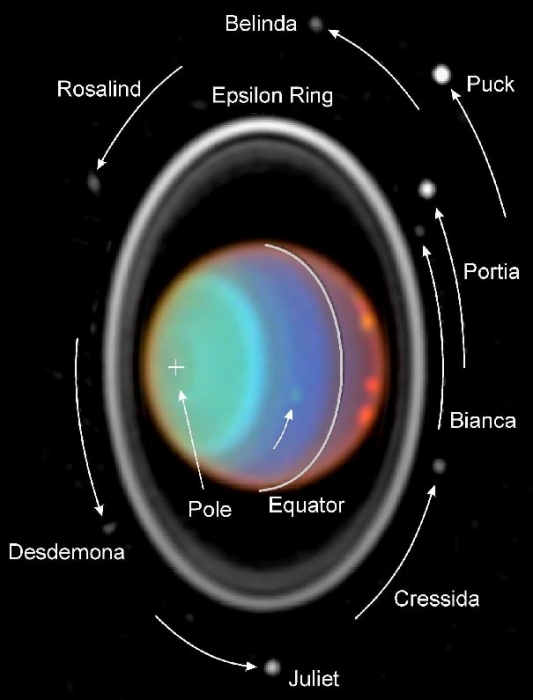
Neptune also has a ring system, but it is not as well observed as those of the other planets. It appears to also contain dust grain-sized particles, but one peculiarity is that its rings are more "clumpy" than those of the other gas giant planets.
Jupiter's moons
Each of the gas giant planets can be thought of as its own mini version of the Solar System. Each planet has a large system of moons which are in orbit around it. Jupiter has more than 60 moons, Saturn has more than 30, Uranus more than 20, and Neptune more than 10.
Exactly how many moons does each Jovian planet have?
When asked this question, I do not often quote a firm number of moons, because astronomers continue to find more. Instead, I usually simply say, for example, that Jupiter has more than 60 moons.
An example of a moon discovered recently (although it is associated with Saturn, not Jupiter) is found in a press release from the NASA Cassini mission. Much more recently, some of Jupiter's "lost" moons were found again, and two new ones were discovered. Jupiter is now inching closer to 70 moons.
The four biggest moons of Jupiter are famous in the field of astronomy because they were part of the revolution to a heliocentric understanding of the Solar System. If you recall back in the earliest lessons in this course, we studied that the ancient astronomers believed that the Earth was the center of the Universe and that all objects (the Sun, the planets, the stars) orbit the Earth. When Jupiter was first observed through a telescope by Galileo, he discovered four moons orbiting this planet, which was evidence that not every object orbited the Earth. This important observation was very influential in the debate over the heliocentric vs. geocentric models of the Solar System.
In modern times, we have observed these four moons in detail, because they are by far the largest of Jupiter's moons and each one has its own interesting properties. They are classified as moons because they orbit Jupiter, but these objects are so large that if they were to orbit the Sun on their own, they might be called planets. The four Galilean moons of Jupiter are called Io, Europa, Ganymede, and Callisto. Their properties are briefly described below, followed by links to images highlighting specific features of those moons.
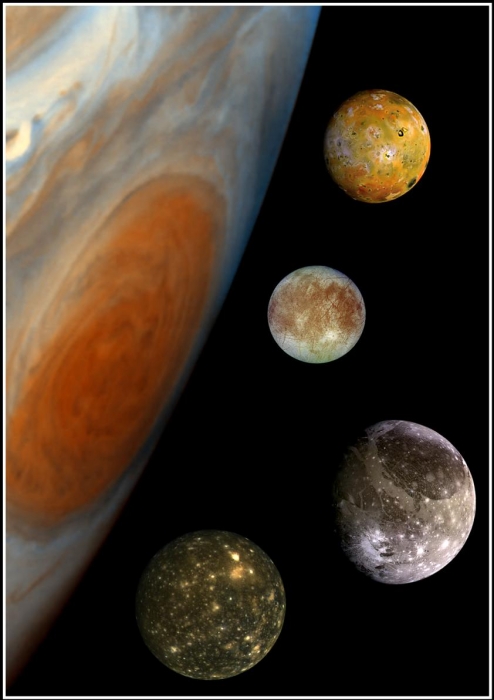
- Io: The innermost of Jupiter's Galilean Moons is very active. Because of the constant deforming of the surface of this Moon by Jupiter's tidal force, the interior of Io is continuously heated, which leads to many active volcanoes on its surface. The moon has over 100 volcanoes that erupt frequently and constantly alter the surface of this moon. Io, therefore, has the youngest surface of any solar system object.
- Europa: Each of the Galilean moons is different in appearance. Europa and Io look nothing alike. The surface of Io looks bright yellow from the sulfur and sulfur compounds emitted by its volcanoes. On the other hand, Europa looks to have a light colored, smooth surface with a network of darker stripes. The evidence from the Galileo satellite suggests that Europa's surface is mostly ice, which is sitting on top of a liquid water ocean. The dark stripes are probably caused by the ice cracking and refreezing. In fact, high definition images of Europa's surface appear similar to antarctic ice images taken from Earth-orbiting satellites. Because of the suspected presence of an ocean on Europa, scientists believe that there is a reasonable probability that life may exist on this moon, underneath the icy surface.
- Ganymede: This moon is the largest moon in the entire Solar System. It is bigger than the planet Mercury. Ganymede again has a different appearance than either Io or Europa. It has some smooth, dark regions with craters visible, and it also has some lighter regions that have deep grooves visible. Some of the surface features on Ganymede may be similar to the fractured ice features on Europa, but others appear similar to fault lines on Earth. Another unique feature of Ganymede is that this moon has its own magnetic field. Some astronomers argue that the magnetic field may be associated with a subsurface ocean on this moon, as well.
- Callisto: The surface of Callisto looks to be the most similar to our own Moon—it appears mostly dark and heavily cratered. The heavy amount of cratering tells us that the surface of this moon must be the oldest among the Galilean moons. There is a large crater with a diameter of several thousand kilometers on Callisto that was created by a major impact. It is somewhat surprising that Callisto survived this impact. Like Europa and Ganymede, recent observations from the Galileo satellite suggest that this moon may also have a subsurface ocean.
Other than the four Galilean moons, most of the rest of Jupiter's moons are small, irregularly shaped bodies that are most likely a mix of rock and ice. Jupiter is such a large planet that it has a strong gravitational pull. Thus, if a small object orbiting the Sun happens to pass too close to Jupiter, it can become captured into an orbit around Jupiter. It is very likely that many of the small moons of Jupiter are captured objects.
Want to learn more?
A comprehensive summary of the moons of Jupiter (and the other gas giants) is online at The Jupiter Satellite Page.
Saturn's moons
Like Jupiter, Saturn has several very large moons and then a few dozen small, irregularly shaped moons. The most famous of Saturn's moons is Titan, which has been known for several decades to have its own atmosphere. Titan, like Ganymede, is larger than the planet Mercury. For a long time, its surface was completely unknown to us. Its atmosphere is somewhat similar to smog on Earth, making it extremely difficult for telescopes to detect anything other than a uniform haze. See the image below, for example.
The chemical composition of Titan's atmosphere and its temperature and pressure have led astronomers to propose that there may be bodies of liquid methane and/or ethane the size of lakes on the surface and it may rain liquids that are similar to gasoline. Hubble Space Telescope images and images from the Cassini satellite mission to Saturn have finally allowed astronomers to penetrate the hazy atmosphere of Titan, revealing that it has surface features, including some that appear to indicate the presence of liquids. The Cassini satellite brought with it a lander that was sent through Titan's atmosphere and landed on its surface in early 2005. The images returned from the Huygens lander showed that much of the speculation about Titan's surface appears to be correct. It has features similar to rivers and lakes that appear to have contained liquid methane at some point. The material the lander landed on is similar in consistency to mud. The below false-color image from radar mapping of Titan's surface shows features that are proposed to be lakes of liquid on Titan's surface.
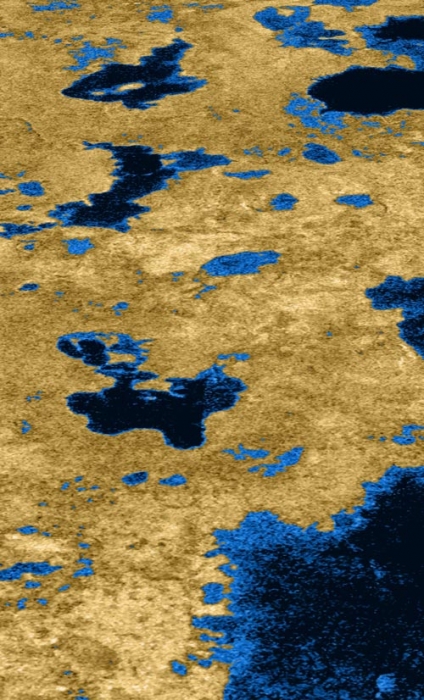
Want to learn more?
Cassini has completed surveying many of Saturn's moons, and, like the Galileo satellite mission to Jupiter, its results have revolutionized our understanding of Saturn's moons. We now have many impressive images of the larger moons of Saturn.
- APOD: Cassini's view of Enceladus -- more recent analyses of Enceladus have discovered giant plumes of water and ice erupting from this Moon, which has led to studies suggesting that it, too, has a subsurface ocean.
- APOD: Cassini's view of Rhea
- APOD: Cassini's view of Iapetus
- APOD: Cassini's view of Dione
- APOD: Cassini's view of Tethys
Saturn does have many small, irregular moons, as well. In the Saturnian system, however, it seems like these moons play an interesting role with regards to the ring system. The gravitational pull of the moons can help keep the rings in narrow, tight orbits (any particle that strays from the ringlet will get ejected or pushed back into the ringlet by the force of gravity from a moon), or they can even clean out gaps in the rings. Here is an image of the moon Prometheus appearing to directly interact with the material in one of Saturn's rings.
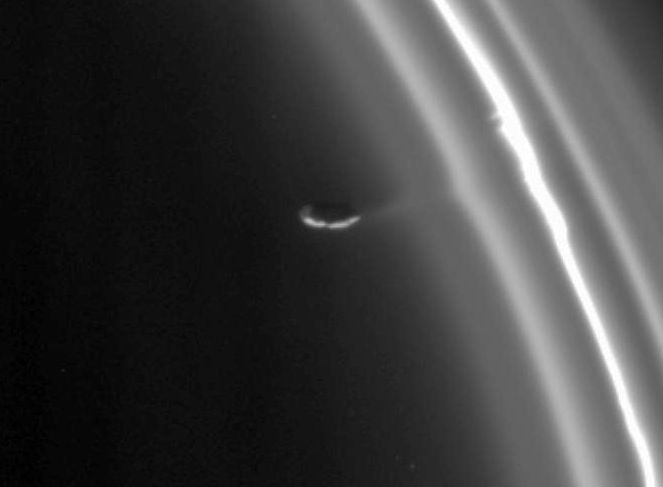
The moons of Uranus and Neptune
The moons of Uranus and Neptune include several that have interesting surface features and properties like several of the larger moons of Jupiter and Saturn. No satellite mission since the Voyager 2 mission has visited these moons, though, so their properties are not as well studied yet as the Galilean satellites and Titan. Below is an image of Triton, a strange moon orbiting Neptune.
Overall, the moons of the Jovian planets are a diverse collection of objects that exhibit a wide set of properties. Many of the moons have been studied in detail by the recent Galileo and Cassini missions, but there is still much more for us to learn.
Pluto and the Kuiper Belt
Additional reading from www.astronomynotes.com
We know that the Sun contains the vast majority of the mass in the Solar System. When we studied Kepler's Laws, we found that we can calculate the orbit of the planets just by figuring out how much the gravitational force of the Sun pulls on each planet. It turns out that this is mostly true. In reality, the gravitational pull of every planet does make minor perturbations on the orbits of the other planets. For example, Jupiter slightly alters the Earth's orbit (and vice versa), Saturn slightly alters Neptune's orbit (and vice versa), and so on. After the discovery of Uranus, astronomers noticed that its orbit was being perturbed by a larger amount than could be accounted for by the other planets known at that time. Thus, they predicted that another massive planet must exist beyond Uranus. Neptune was discovered based on these predictions. Even after this discovery, though, astronomers felt that perturbations in the orbits of Uranus and Neptune meant that another planet must still exist beyond Neptune.
Based on these predictions, Clyde Tombaugh carefully studied photographs of the sky and found a faint object that was moving compared to the background stars. The object discovered was not massive enough to perturb the orbit of Neptune, so its discovery appears to have been accidental! This object was named Pluto and was determined to be the ninth planet in the Solar System. However, as we have learned more and more about Pluto since its discovery, it appears to be different from our expectations in a number of ways.
Want to read more?
The story of the discovery of Pluto and the controversy over its current status is summarized very well in the book, Is Pluto a Planet?
Another excellent book that discusses the discoveries of other, massive objects in the same part of the Solar System is How I Killed Pluto and Why it Had it Coming. This is my personal favorite astronomy book, and I recommend it highly.
First of all, you should realize that Pluto is, by far, the most difficult of the nine historical planets to study. It is very distant and very faint, and so, prior to July 2015, no satellite had visited Pluto. The NASA New Horizons mission performed a flyby of the Pluto system in mid-2015. The Hubble Space Telescope is not powerful enough to reveal much about the planet Pluto. Compare these Hubble Space Telescope images of Mars (top image) and Pluto (bottom two images) to see the difference in the quality of data on the two planets.
Now that New Horizons has provided us with much higher resolution images of Pluto and Charon, it is clear how fascinating these worlds are. The scientific work in analyzing these images is not yet done as of your time working on this course, however, many surprises have already been discussed by the New Horizons team. In particular, Pluto's surface appears to be much more active than was expected.
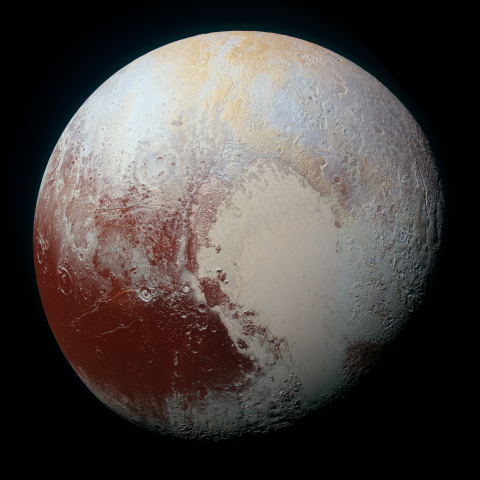
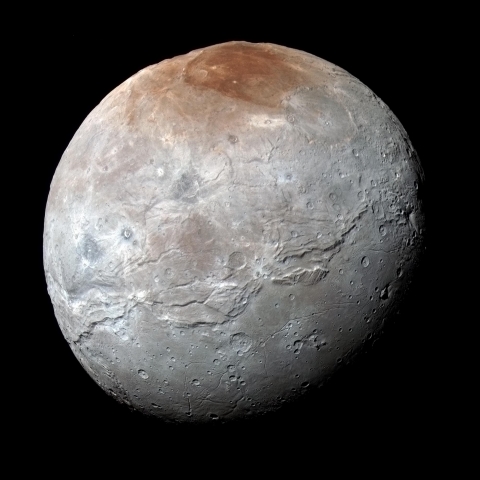
Prior to New Horizons study of Pluto, we discovered from the ground that Pluto has one large moon, called Charon (pictured above), which is roughly half the size of Pluto. Pluto is approximately 2300 kilometers in diameter and Charon is approximately 1300 kilometers in diameter. By observing the two objects orbit each other, we can also calculate their masses using Kepler's laws. We find that Pluto contains less than 1% of the mass of the Earth, and Charon is about 10% of Pluto's mass. Combining our knowledge of the mass of these two objects and their sizes, we can calculate their density, which comes out to approximately 2 g / cm3 and suggests that these objects are a mix of ices and rock.
The orbital properties of Pluto and its largest moon are also peculiar. Like Uranus, Pluto appears to have its rotational axis almost perpendicular to its orbital axis. That is, it is orbiting on its side compared to most of the planets in our Solar System. Charon's orbit around Pluto is aligned with Pluto's rotation axis, so, from our point of view on Earth, Charon appears to orbit Pluto perpendicularly to the path Pluto takes around the Sun. Perhaps the most peculiar aspect of Pluto's orbit is its inclination compared to the Earth's orbit around the Sun. If you define a plane containing the Sun and the Earth, you can measure the angle that each other planet's orbital plane makes with the Earth's orbital plane. Most of the other planets have orbital inclinations of less than 3.5 degrees from the Earth's orbital plane. Mercury is inclined by more than 7 degrees, but Pluto's orbit is inclined by almost 20 degrees. So, compared to the planets, Pluto's path takes it from a point high above the Earth's orbital plane to another point below the Earth's orbital plane. See the below image captured from Starry Night.
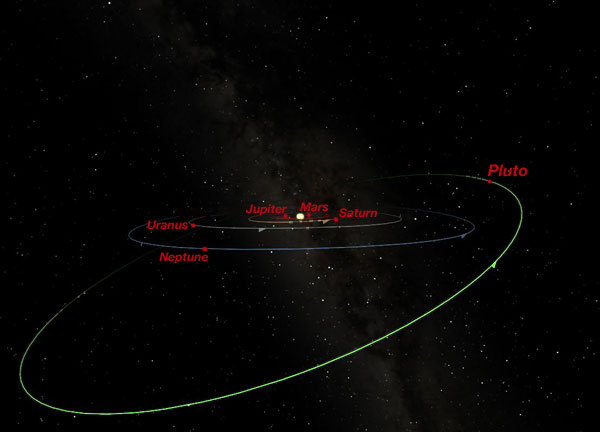
In recent years, there has been some controversy over the classification of Pluto as a planet. It is much smaller than the outer planets, and in fact, it is smaller than many moons, including Io, Europa, Ganymede, Callisto, Titan, and Triton. Its peculiar orbit also suggests that it may have had a different origin than the planets. Some astronomers suggest that perhaps Pluto is not a planet after all, but a different class of object. Recent discoveries of other, similar objects suggest that Pluto may be just one of a family of objects outside the orbit of Neptune.
Beyond Neptune, astronomers have discovered a large population of objects with sizes of about 100 kilometers or so up to more than 2000 kilometers. These are called “Kuiper Belt Objects” or KBOs, after the astronomer Gerard Kuiper. There is some controversy about whether or not Kuiper predicted the existence of the objects that are named after him, so sometimes the class of objects are more simply referred to as trans-Neptunian objects or TNOs.
The Kuiper Belt is a region of space in the Solar System that is donut-shaped. Its inner radius is just past the orbit of Neptune at 30 AU, and it extends out to perhaps 50 AU or farther. The thickness of the Kuiper Belt is approximately 10 AU. Inside of this region perhaps up to 100,000 KBOs orbit the Sun!
Recently, several large objects have been discovered in the Kuiper Belt that has sizes similar to Pluto's moon, Charon. Some have formal, approved names, and others have informal names. The largest of these objects include: Quaoar, Haumea, Makemake, Orcus, Ixion and Varuna. There is an excellent, well-maintained image of these objects to scale at Wikimedia Commons. To get a general idea of the properties of this class of objects, you can investigate further Quaoar as an example.
Want to learn more?
- The discoverer of the first KBO and many other KBOs maintains an in-depth website devoted to these objects, and it contains far more detailed information than I can include here. If you are interested, please visit The Kuiper Belt Page.
- To investigate Quaoar, check out:
The discovery of these objects in the Kuiper Belt with sizes comparable to Charon suggests that there are more large KBOs left to be discovered. Because these objects are small and extremely distant, they are difficult to observe. The brightness of many of them is comparable to some of the faintest stars in the Milky Way and to some of the faint galaxies in the Hubble Deep Field. Although several groups of astronomers have searched the sky for KBOs and found many of them, they expect that perhaps a few dozen more 1000 kilometer size KBOs remain undiscovered. There may even be several Pluto-sized KBOs, too. In 2016, it was suggested that there may be a planet similar to Uranus and Neptune in the Kuiper Belt based on evidence from the motion of several unusual KBOs. This object is being referred to as "Planet 9" by the researchers who proposed its presence, but it has yet to be found if it does in fact exist.
In 2003, an image taken by the team that discovered many of the other large KBOs included an object that was provisionally named 2003 UB313. Initial estimates revealed that it was perhaps larger than Pluto. For this reason, its discoverers and many in the community were expecting it to be named the tenth planet. The International Astronomical Union (the IAU) is the organization that approves the names of newly discovered objects in the Solar System. In 2006, they took on the task of defining the word planet. Instead of adopting a definition that would classify 2003 UB313 as a planet, they created a category of objects called dwarf planets. A side effect of this decision is that Pluto no longer fits the definition of a planet, but is classified as a dwarf planet too. After this decision, 2003 UB313 was given its official name of Eris, and we now know that it is more massive than Pluto, although the objects have been found to be quite closely matched in diameter.
While the new definition of a planet is firmly grounded in science, the names of classes of objects is really an issue of semantics. The point I impress when I'm teaching about the Solar System is that Pluto is still as large and as massive as it was when it was discovered. It follows the same orbit, and all in all, it is identical to the object it was before it was demoted from planet status. I think the terminology of dwarf planet is unnecessary. Instead, I prefer to point out that Pluto was the first large KBO discovered, and rather than being an oddball of a planet, it is the prototype of the class of large KBOs. I like to flip this particular question around with my undergraduate students. In classes where I have time and the resources, I ask students in groups to research and study the properties of all of the large, round objects in the Solar System. Then, I ask them as a group to answer the question, "How can we organize the large, round objects in the Solar System by their properties?". Planetary scientist and writer Emily Lakdawalla maintains an excellent image of all of the round objects in the Solar System less than 10,000 km in diameter, which can be used as a resource for students pursuing this investigation. If you study the properties, you do find that the terrestrial planets (Mercury, Venus, Earth, and Mars) have very similar properties and the Jovian planets (Jupiter, Saturn, Uranus, and Neptune) share properties. However, the other objects in the Solar System can be grouped in various ways, and Pluto shares properties with many other objects, but not with the planets. Often this leads to a discussion that the names we have traditionally used -- planet & moon -- are insufficient for categorizing these objects. It really does seem like we need to either call many dozens of objects planets, or only 8. There is no clean, scientific categorization of the large, round objects in the Solar System that leads to 9 planets with Pluto being the 9th.
Pluto has a larger albedo than most KBOs, making it appear brighter on Earth and easier to observe than most KBOs. However, in all other respects, Pluto is probably very similar to Eris, Quaoar, Ixion, and Varuna. So, while we now only recognize 8 planets, we have a number of new interesting objects to study in addition to Pluto. We continue to learn more about these objects. Eris is now known to have a small moon named Dysnomia, and Pluto was found to have two more moons, Nix and Hydra, in 2006, and two other new moons, Styx and Kerberos, in 2011 and 2012. These were also imaged by New Horizons, but in far less detail than Pluto and Charon.
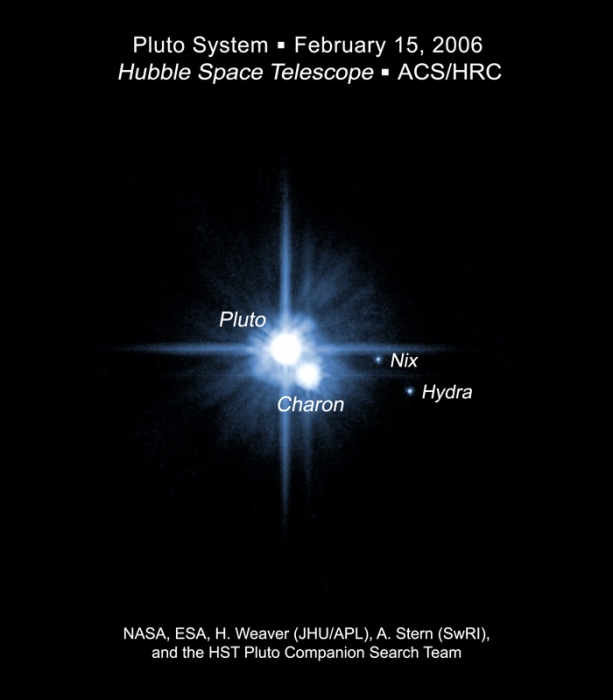
The story of the status of Pluto is likely to change, and I expect astronomers to continue to identify large KBOs. The story to date has been exciting, and I recommend investigating it much more deeply than we have here.
Want to learn more?
- The IAU has an informational website on their role in the debate over the status of Pluto.
- Mike Brown maintains a highly detailed website on the discovery of Eris and his feelings about its classification.
Comets
Additional reading from www.astronomynotes.com
Among the objects that you may have seen in your lifetime or may expect to see in your lifetime besides the Sun, Moon, stars, and planets, are a class of objects called comets. Comets appear to us very differently than all of the other objects that we have seen. Instead of points of light or disks of light, these objects appear to have a long, narrow tail of diffuse light extending from a bright nucleus. One of the best recent examples of a naked eye comet was Comet Hale-Bopp.
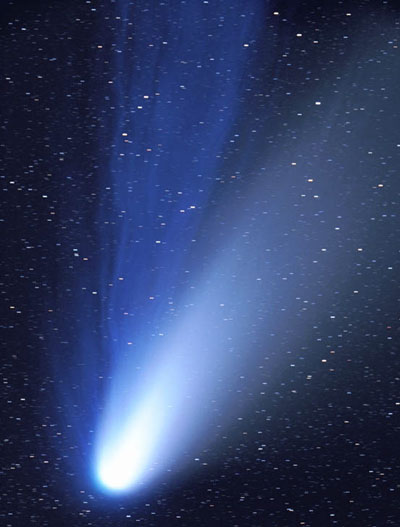
Observations of comets have shown that the object itself is usually a quite small, irregularly shaped body. It is mostly made up of some rock and some different kinds of ices (water ice, dry ice or carbon dioxide ice, methane ice, etc.); so, many astronomers refer to comet nuclei as "dirty snowballs." Like Pluto, a comet nucleus was just imaged in much higher resolution by a recent robotic mission called "Rosetta". This image of Comet 67P Churyumov-Gerasimenko shows in great detail what one of these dirty snowballs looks like underneath the bright obscuring light. As comets approach the Sun, however, they undergo significant changes. As a comet absorbs heat from the Sun, the ice and rock particles that make up the nucleus heat up, and they form a large atmosphere around the nucleus, which is called the coma. As the comet moves through space, some of the solid particles in the coma trail off behind, forming a long, curved dust tail. The charged particles in the gaseous coma get pushed away by the Solar wind along the magnetic field lines that point outward away from the Sun, and they form a separate "ion tail," or gas tail. In many pictures of comets, you can see both tails—the straight, sometimes bluish colored ion tail and the curved, white dust tail, which is seen in the following APOD image.
The nucleus of a comet is usually only a few kilometers in size, the coma can be hundreds of thousands of kilometers in size, and the tails can be about an AU (150 million kilometers!) in size. Although these objects are both large in extent and can be very bright, they are actually very fragile because they do not contain much mass (the tails of a comet are spread very thinly over a very large region of space). The tails of a comet are so thin that the Earth can pass through them with no problem whatsoever, and, as I will point out shortly, this does happen with some regularity. The nucleus of a comet is very loosely bound together, so they can break into many pieces, which may destroy the comet completely, or the comet may wind up actually colliding with the Sun, which is another method by which comets die. The most famous example of this phenomenon is Comet Shoemaker-Levy 9, which impacted Jupiter after fragmenting into a number of pieces. During July of 2009, an amateur astronomer observed what appeared to be an impact spot on Jupiter very similar to the ones left behind by Shoemaker-Levy 9, and it has now been confirmed that Jupiter just suffered another, similar impact. APOD has an image of the impact scar and the story.
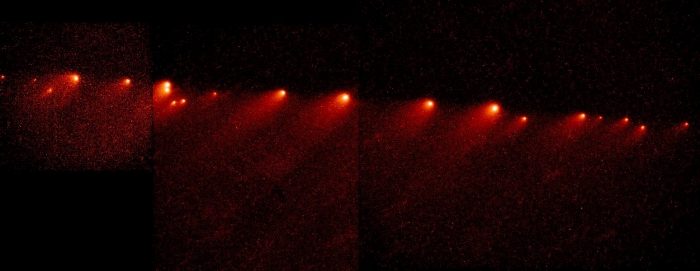
The orbits of comets determine their fate, and they also tell us about their origin. The orbits of comets are very different from the orbits of the planets. Planetary orbits are close to circular, while cometary orbits are usually much more elongated ellipses. A comet's nucleus is only a small, dirty snowball, and when it is far from the Sun along its orbit, it will not have a coma or tail. However, if its orbit takes it close to the Sun, then the process of creating a coma and tail will begin. If the comet is big enough or comes close enough to the Earth, we can see it in reflected sunlight without the use of a telescope. The Windows to the Universe website presents an excellent simple animation of the typical orbit of a comet. Starry Night can show you the orbit of any known comet, so you can use it to follow Comet Halley, Hale-Bopp, 67P, or any of the many other well-known comets.
We can only see comets when they have visible tails and comas when they are near the Sun. However, we can trace their orbits into the outer Solar System to determine their place of origin. We have found that some comets appear to originate in the Kuiper Belt, the same region inhabited by Pluto and the KBOs. However, it appears that the majority of the comets that we observe come from a more distant region of the Outer Solar System that may stretch almost as far as 50,000 AU, most of the way to the nearest star. Unlike the Kuiper Belt, which we think is a donut-shaped region aligned with the planes of the planets' orbits, this outer region that is made up of comet nuclei is likely to be a spherical region that completely surrounds the Solar System. The reason that we expect this region to be spherical is because the comets that we think come from this region enter the inner Solar System on orbits that are not always aligned with the planets' orbits, unlike those comets that come from the Kuiper Belt. This outer region of the Solar System is usually referred to as the Oort Cloud because it was proposed by the Dutch astronomer Jan Oort. There are likely to be a very large number (perhaps trillions) of comets that live in the Oort Cloud, and only rarely will one of them be pushed out of the Oort Cloud into an orbit that will bring it close enough to the Sun to be visible.
Recently, astronomers searching for objects in the Kuiper Belt found a 1000 km sized object that appears to be on an orbit that takes it out past the boundaries of the Kuiper Belt and into what may be the inner portion of the Oort Cloud! This object, called Sedna, is the first larger-than- comet-sized object known that may be part of the Oort Cloud, lending some observational evidence to the existence of this region. Although the majority of objects in the Oort Cloud are expected to be small comet nucleus-sized bodies, the discovery of Sedna does suggest that perhaps there are other large bodies in the Oort Cloud.
Want to learn more?
Cal Tech has a nice website full of information about Sedna written by the team who discovered it.
Although comets are fragile objects and their tails are so thin as to be almost insignificant, the collision of Shoemaker-Levy 9 with the planet Jupiter has shown us that we should be wary about the possibility of a comet's nucleus colliding with the Earth. Telescopes around the world watched as each chunk of the comet's nucleus impacted Jupiter, releasing immense amounts of energy.
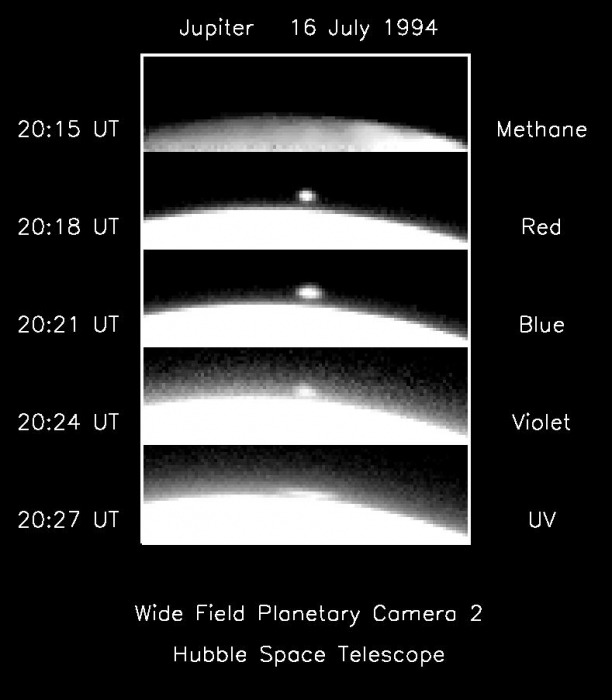
Impact sites in Jupiter's atmosphere were visible long after the impacts, as shown in the Hubble image below. Along with friends, I was able to see these dark spots through an amateur telescope with an aperture of 14 inches.
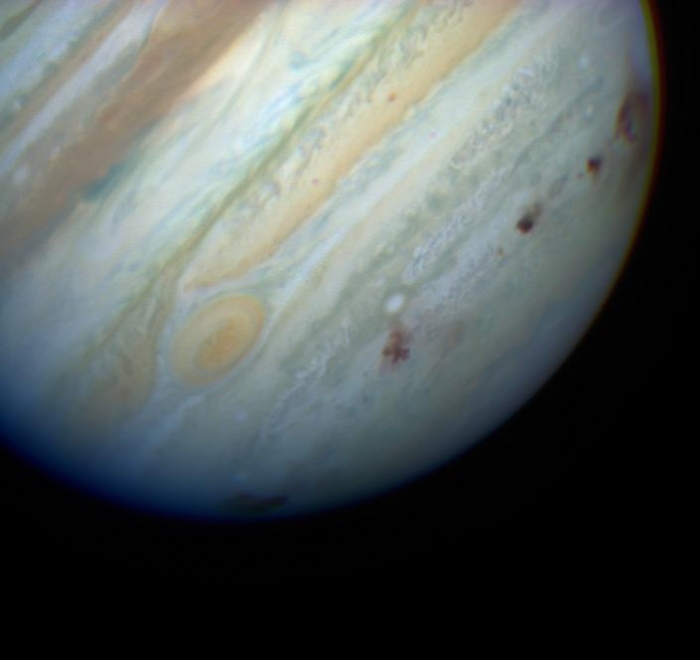
This next image, showing a crater chain on Ganymede, suggests that impacts like the Shoemaker-Levy 9 collision with Jupiter have happened before.
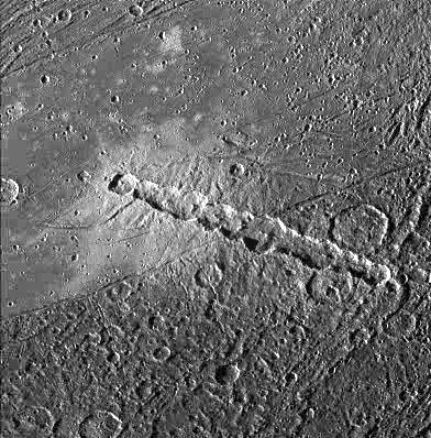
Source: APOD
One important point to take away from the Shoemaker-Levy 9 impact on Jupiter is that the giant planets in the outer Solar System have a significant gravitational effect on comets. They can capture comets, redirect them, and even, as in the case of Shoemaker-Levy 9, destroy them. Jupiter has the largest influence on comets, and it appears that it is responsible for directing the orbits of comets into the inner Solar System where we can observe them. However, the other giant planets also affect comets. For example, observations by Cassini of one of Saturn's moons, Phoebe, suggests that it may be a comet from the Kuiper Belt that was captured by Saturn.
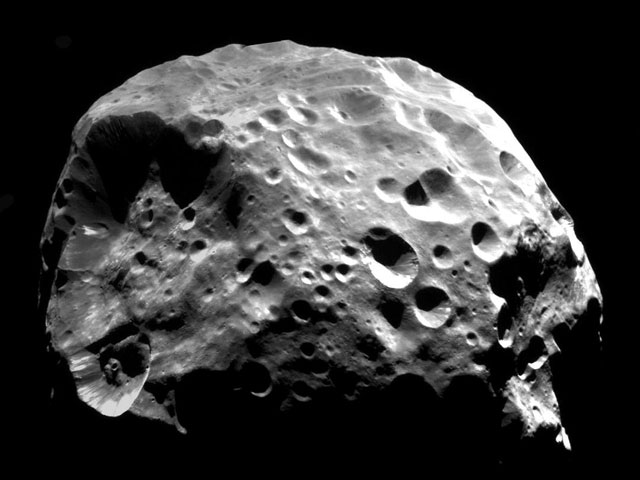
Meteors and Asteroids
Additional reading from www.astronomynotes.com
If we take a complete inventory of the entire contents of the Solar System, we find that there are many small, rocky bodies ranging in size from similar to grains of sand up to the size of small moons or comets. The smallest rocky objects that are found in space are referred to as meteoroids. There are three different classifications of meteoroids, depending on how they are observed:
- Meteoroid: A chunk of rock orbiting the Sun inside the Solar System.
- Meteor: When a meteoroid encounters the Earth's atmosphere, it interacts with the gases in the atmosphere and all or most of it gets vaporized. The streak of light that we see as the rock penetrates the atmosphere is called a meteor, which many people refer to as "a shooting star."
- Meteorite: If some of the material that makes up a meteoroid survives the trip through the atmosphere and is found on Earth, we refer to the remnant as a meteorite. If you want help identifying candidate meteorites you can see the following page:
There are many meteorites that have been recovered on Earth. We find that there are several types of meteorites that can be separated based on their composition. Some meteorites are almost entirely made up of iron and nickel. These chunks of metal are very easy to find when they land on the Earth because they are so dense and are essentially chunks of metal. There are also stone and stony-iron mix meteorites that land on the Earth (these are more common), but since they appear to the untrained eye more like the naturally occurring rocks on the Earth, without extensive testing they are more difficult to identify as meteorites. During its mission, the Mars Rover Opportunity discovered an iron meteorite on Mars. It just happened to be lying on the planet's surface right near where the Rover's heat shield landed after the spacecraft jettisoned it. This is an iron meteorite, making it stand out among the other rocks the Rover has studied intensively during its trip around the surface of Mars.
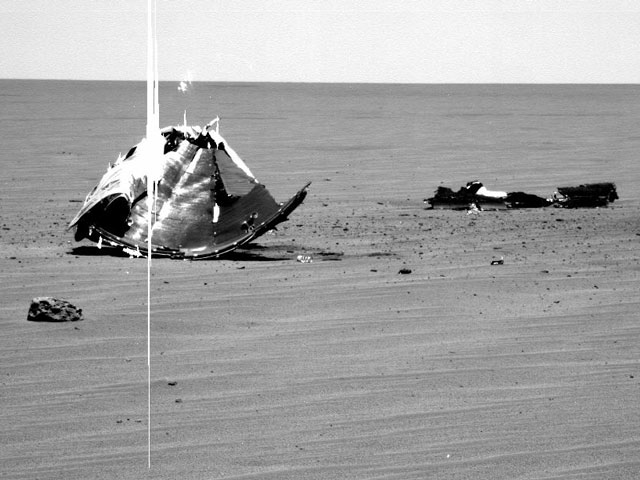
Some of the meteorites that have been found on the Earth have been able to be identified as having originated on the Moon or even Mars. These are very useful meteorites because they allow us to study the surfaces of the Moon and Mars without having to send a mission to these places and return samples. A number of years ago, several NASA scientists thought they found evidence of fossilized life forms in a Martian meteorite. This result remains controversial though, so it is not widely accepted any longer among astronomers. There has been another, more recent report about potential indications of life in a different Martian meteorite, but this too is considered unlikely to be correct.

Although Moon and Mars rocks are occasionally found on Earth, the majority of the meteorites recovered on Earth appear to have been orbiting the Sun for billions of years prior to landing on the Earth. In fact, many of them, when dated, appear to be the same age as the Sun and the Earth—about 4.6 billion years old. Chondrules in meteorites (round mineral grains like the ones in the image of the Allende meteorite below) have been determined to have ages of more than 4.5 billion years, so the study of these grains allows astronomers to learn about the conditions in the early Solar System, when the planets (and these meteorites) were forming.
Because these meteorites appear to be as old as the Sun, they must have formed in the early days of the Solar System. Thus, astronomers think that their composition tells us about the conditions in the early Solar System when the planets were forming.
Want to learn more?
There are many resources out there on meteorites. In particular, there is a publication called "Meteorites and Their Properties." The Arizona State University Center for Meteorite Studies also has provided a page with educator resources about meteorites.
During the year, there are times when there are known “meteor showers” that are visible in our night sky. These usually occur every year, and there are times when the rate of visible meteors in the sky is much higher than average (perhaps up to 1,000 meteors per hour!). Clearly, what must be happening is that the Earth must be periodically passing through an area of space with a lot of small meteoroids. Astronomers have found that, in most cases, the times of meteor showers match well with the expected times that the Earth is passing through the known debris tail from a comet that passed by in the past. Since the tails of comets contain chunks of the nucleus the size of meteoroids, these objects all create visible meteors when the Earth collides with them. Thus, we know that the Earth is passing through the tails of comets frequently, and there is no harm done.
However, this does not mean that comets and meteors cannot harm the Earth. As mentioned above, if a comet's nucleus were to collide with the Earth, this would cause an immense amount of damage. The same would be true if a large enough meteorite were to impact the Earth's surface. Recall the image of Barringer Crater. Clearly, that impact must have been enormous to have excavated such a large area of Earth's crust.
The meteorite that created the Barringer crater was much larger than the average meteorite, but statistically, we expect that such impacts may occur every 10 million years or so. It has been suggested that an even larger impact that occurred about 65 million years ago was responsible for global changes that killed all of the dinosaurs. This theory has been strengthened with the discovery of the remnants of a crater (called the Chicxulub crater) about 200 kilometers across that is about 65 million years old.
Because large impacts on Earth have such potential for catastrophic events, astronomers have begun to systematically search for and catalogue all of the large “Near Earth Objects” (NEOs) that may impact the Earth. There have been several reports in the news of potential NEOs that may impact Earth, and even two Hollywood movies on the subject. At this time, though, no NEOs are on paths that are known to impact the Earth. However, to be safe, astronomers continue to study these objects in order to determine if we need to worry and to plan for what to do in case we do discover an NEO on a collision course with Earth.
Asteroids
The impactor that created the Chicxulub crater was not technically a meteoroid; it was too big. There is another class of object known as asteroids that are basically the same as meteoroids, just larger. Sometimes these objects are also called minor planets. There are several large asteroids—like Ceres, Pallas, and Vesta—which are about 900 km, 500 km, and 500 km in diameter, respectively. As the largest, Ceres is actually one of the handful of objects classified using the new dwarf planet designation. Most of the other known asteroids are smaller, in the range of 10 - 100 km or so.
The majority of asteroids are all found in a belt between the orbits of Mars and Jupiter. Although you have probably seen spaceships flying in “asteroid belts” in movies like Star Wars, the asteroid belt in our Solar System is not very densely packed. On average, the separation between the largest asteroids is very large (more than 1 million kilometers, or about 10,000 of their diameters), so NASA missions to the outer planets, such as Galileo and Cassini, easily passed safely through the asteroid belt.
Like comets, the planets can alter the orbits of asteroids. It looks like Mars, Jupiter, and Saturn may have captured asteroids as part of their systems of Moons. For example, the two Moons of Mars (Phobos and Deimos) are small, irregularly shaped objects that look much more like asteroids than the nearly spherical moons like Earth's Moon.
In fact, if you compare the image above of Phobos to the one below of Asteroid Ida, there are a number of similarities between these two objects.
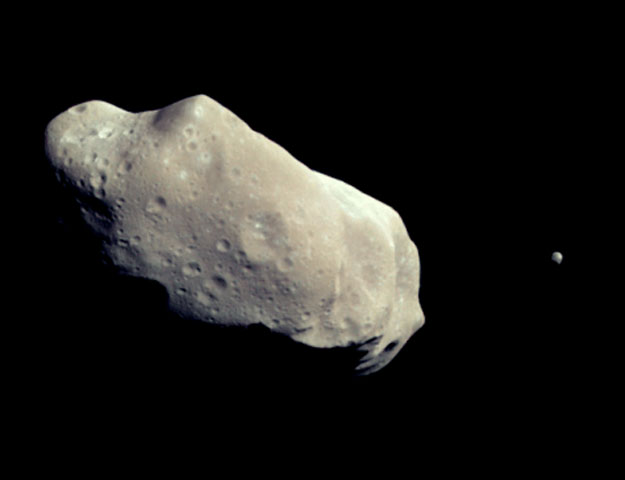
Formation and Evolution of the Solar System
Additional reading from www.astronomynotes.com
The amount of information and detail in the past pages is significant, but in the interests of time leaves out a great amount of additional information we know about the objects in the Solar System. However, if we think specifically about the patterns in the data about the objects, a few things do stand out:
- The largest objects are confined to a narrow plane that matches well with the equator of the Sun;
- The large objects nearest to the Sun, are smaller, denser, have fewer satellites, and are more closely spaced than the ones further from the Sun;
- The largest objects in the Solar System orbit the Sun in a counterclockwise direction, and most rotate counterclockwise around their axis;
- The smaller objects in the Solar System are often irregularly shaped and found primarily in two regions; the Asteroid Belt and the Kuiper Belt;
These patterns were used to create a model for how the Solar System may have formed as part of the process of our Sun's formation as described in our discussion of star formation in Lesson 5. The model we have used for years to describe the formation of the Solar System is often referred to as "Solar Nebula Theory", although some sources (e.g., www.astronomynotes.com) refer to it as the condensation model. The main idea is that after the collapsing gas cloud that formed the Sun created a flattened protoplanetary disk, planets, moons, asteroids, comets, and other objects condensed out of the disk.
Because all of the objects in our Solar System likely condensed out of a rotating, flattened disk, the objects maintained the angular momentum of that disk, and therefore they orbit and rotate around the Sun in the same direction as the original disk.
As the Sun was forming, the disk was first heated up, and then it began to cool. The regions nearest to the Sun cooled more slowly than the outer part of the disk, creating distinct zones where different materials were available to form objects. Heavy elements and molecules were able to condense and solidify in all parts of the disk. Beyond an "ice line" several AU from the Sun, it was cold enough that different materials could form ices (e.g., water ice, methane ice, and others). Closest to the Sun, solid worlds were able to accrete together, while beyond the ice line, lower density objects accreted because there were less dense raw materials available.
Smaller objects formed as single objects in the disk. The largest "protoplanets" (like the one that formed Jupiter) were able to form mini-disks around themselves, and they formed planet-sized moons in the disk around themselves. Collisions were common all throughout the disk, though, and some collisions were able to form moons around the smaller planets or to reverse the rotation direction of the new, solid planets.
Not all areas of the Solar System went through this process to completion, leaving behind remnants of the planet formation process. These small, irregular bodies became the asteroids, comets, and Kuiper Belt objects we studied previously.
This was the state of our model for Solar System formation for many years. However, as we have tried to explain some of the peculiarities in our own system as well as in other planetary systems (which we will see briefly in Lab 4 and Lesson 12), we have refined Solar Nebula Theory. In particular, it appears that "migration" is an important process. During the planet formation process, interactions between the planets and the disk can cause them to spiral inward towards the forming star. Gravitational interactions between the planets can also cause them to move outward. For example, there is a particular model referred to as the "Nice Model" (after the French city) that shows that Saturn was able to pull Jupiter outward. During this interaction, Neptune moved outward and swapped places with Uranus. Some of the small bodies of the Solar System were trapped into certain orbits (e.g., Trojan asteroids that lead and trail Jupiter in its orbit or Pluto, which is trapped into a 3:2 resonant orbit with Neptune), while many others were ejected from the Solar System. As Neptune moved outward, it flung many small bodies into the inner Solar System, where they impacted the planets during a period called the "Late Heavy Bombardment". There is a nice, short video segment on this from the BBC. The Nice Model is not the final word on the formation and evolution of the Solar System, but we think a combination of Solar Nebula theory and migration of the planets is how our planets formed. In the intervening 4.5 billion years, the bodies in the Solar System have continued to evolve into the worlds we see today.
Additional Resources
As you might imagine, there is a wealth of resources on planets and the Solar System, including a number of excellent activity guides for use in the classroom. A sample of some is below:
- The overall home of NASA's Mars Exploration Program has all the information on this planet that you are likely to want. The Mars education resource page that existed here once upon a time seems to have disappeared, but ASU still maintains a set of Mars STEM lesson plans
- Saturn has its own similar site at the Cassini Solstice Mission site. After the end of the Cassini mission, it appears that they moved many of the Cassini Saturn education resources to JPL.
- You can search the directory and contact a NASA Solar System Ambassador in your area to do a program at your school.
- Other NASA Solar System Missions include:
- The New Horizons Mission is on its way to a distant Kuiper Belt Object after leaving Pluto, and they have resources for teachers about Pluto.
- The Lunar Reconnaissance Orbiter studied the Moon, and they have resources for teachers about the Moon.
Summary
This is the longest, most detailed lesson to date. It should be obvious that this is another case where we could have made an entire course out of the material, rather than spending a single week studying the Solar System in detail. This is a topic area within astronomy that is likely to be more familiar to many students than some others, so I think it is one where you might consider some of the less familiar aspects to concentrate on in your teaching. While we did look at some of the familiar aspects of this topic, we also covered the moons as individual, interesting objects in their own right, considered Pluto as the archetype of the class of KBOs rather than a planet, and looked at how the properties of the Solar System as a whole provide insight into its origin.
Activity 1 - Lesson 11 Quiz
Directions
First, please take the Web-based Lesson 11 quiz.
- Go to Canvas.
- Click on the link to the "Lesson 11 Quiz" and complete the quiz.
Good luck!
Activity 2 - Lab 4
Directions
During this week, you should work on and complete Lab 4, which is due at the end of this Lesson.
- Under Lesson 11 in the Course Outline box (see the menu bar at left), click on "Lab 4."
- Follow the instructions to begin your comparison of the Solar System to the known extrasolar planets.
Reminder - Complete all of the lesson tasks!
You have finished the reading for Lesson 11. Double-check the list of requirements on the Lesson 11 Overview page to make sure you have completed all of the activities listed there before beginning the next lesson.
Lab 4
Background
The discovery of planets outside the solar system was a major turning point in the history of astronomy because it revealed that not all systems resemble the system we live in. In this lab, you'll look at data on some known extrasolar planets using publicly-available data to draw conclusions about the nature of extrasolar planets.
Directions
This lab exercise consists of only one "part," and all of the exercises are given below. Please record your answers to ALL of the items below in a single document.
NOTE: You will be submitting this lab as a single document that is in either Microsoft Word (.doc) or PDF (.pdf) format so I can open it.
- There are eight planets in the Solar System. Some data on these planets is provided below. For each planet, calculate its density relative to the Earth's density:
Planet Data Planet Distance from the Sun (in AU) Mass (Earth Masses) Radius (Earth Radii) Mercury 0.387 0.06 0.382 Venus 0.72 0.82 0.949 Earth 1.00 1.00 1.00 Mars 1.52 0.11 0.53 Jupiter 5.20 318 11.2 Saturn 9.54 95 9.41 Uranus 19.22 14.6 3.98 Neptune 30.06 17.2 3.81 - There are two types of planets in the solar system, terrestrial planets (like the Earth) and gas giants (like Jupiter). How do the mass, radius, and densities of these planetary types differ?
- Let's say you discover a planet that's 50 times the mass of the Earth. Even without visiting the planet, what might you presume about the planet?
- How do the distances from the Sun differ for terrestrial and Jovian planets?
- Go to the http://exoplanets.org/ website. (We will discuss extrasolar planets in more detail in Lesson 12.)
- Scan the page. How many planets have been discovered to date?
- Click on the "Plots" button.
- Click on the Histogram Plot button near the top right, and it will show you histograms of the properties of the candidates (for example, the numbers of objects in given ranges of mass). Select various properties to plot and observe the results. If the histogram looks odd and doesn't seem to show more than one bar, choosing the "Logarithmic bins" option should improve the plot.
- Click on the "Add Filter" button in the "Configure Histogram" area on the page. Click on the plus sign on the right side of the Filter box, and it will bring up a menu. Choose "Table Filter RV Planets" to select only those planets discovered using the radial velocity method.
- Answer the following questions:
- Are most of the planets found using this method more massive or less massive than Jupiter? Note that the unit "MJ" means "Jupiter masses".
- Do most of these planets have orbital periods that are shorter or longer than a year? (Note, you should select "logarithmic bins" for this one)
- Are most of the planets closer to or farther from their stars than the Earth is to the Sun?
- Click on the "Scatter Plot" button. Here you can look at the relationship between different planetary and stellar parameters.
- Create and inspect a plot with an x-axis of "Planet Semi-Major Axis" and a y-axis of "Planet Mass". Do you notice any patterns or clumps? If so, describe them.
- Using the data in the table above, eyeball where Jupiter, Saturn, Uranus, and Neptune would lie on your plot. Do any of the Jovian planets in our Solar System lie in any of the clumps on the plot? Describe their location.
- Write a summary that includes a short comparison between the properties of the planets in our Solar System that you studied above to the properties of the extrasolar planets you studied here.
- Save your work (that is, all of your answers and your summary) AS A SINGLE DOCUMENT in either a Microsoft Word or PDF file in the following format:
Lab4_AccessAccountID_LastName.doc (or .pdf)For example, student Elvis Aaron Presley's file would be named "Lab4 _eap1_presley.doc" - This naming convention is important, as it will help me make sure I match each submission up with the right student!
Submit your work
Please submit your work to the Lab 4 dropbox in ANGEL by the due date indicated on our ANGEL calendar.
Grading criteria
See the grading rubric for specifics on how this assignment will be graded.
